Antalya – Visiting Another Great Turkish City
Our western Turkey odyssey with Adventures Abroad continues as we depart the site of ancient Phaselis and head for the city of Antalya where we will spend a few days exploring both the city and the surrounding area. It is the largest Turkish city on the Mediterranean coast (Izmir is on the Aegean Sea) with a population of around one million and is actually the fastest growing city in the country. There’s a good reason for this as Antalya has a beautiful location on the coast with the fabled Taurus Mountains in the background. It is home to one of the largest and best preserved historic districts in the country, lined with Ottoman houses. Other parts of Antalya feature leafy boulevards and seaside promenades. It also has one of the best archaeological museums in a country famous for them. Please join our small group as we explore this most interesting city.
It’s a short drive from Phaselis to Antalya, almost all of it with views of the Mediterranean on the right hand side and the Taurus Mountains on the left. Our guide Yasemin advises that we will be staying in the heart of the historic district where the streets are too narrow for our bus. So we get as close as possible and then she leads our way through the narrow streets where the second story overhangs of Ottoman houses are a common sight.
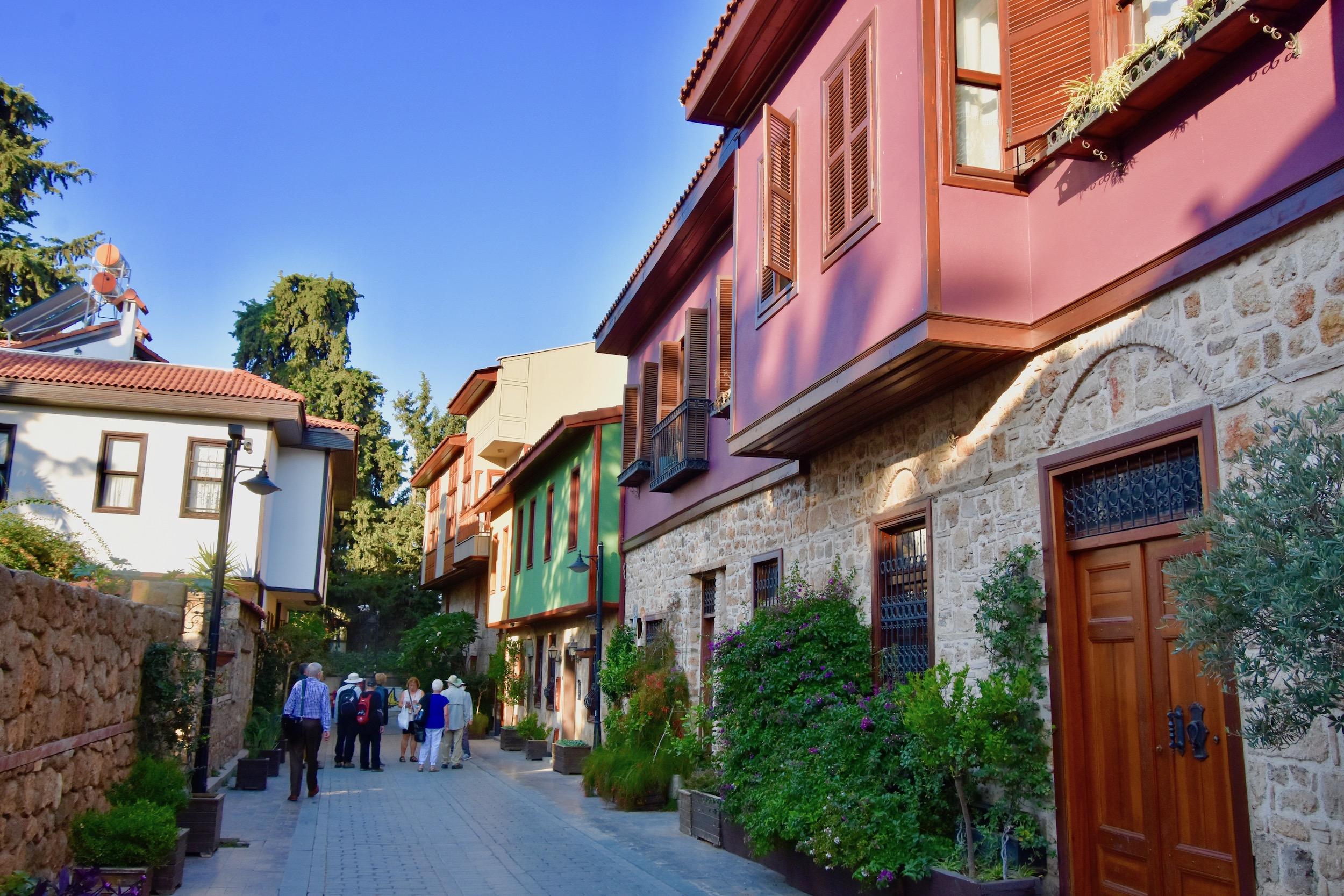
Our luggage has been taken care of by porters from the hotel we are headed for which is a couple of blocks from where we got off the bus.
Puding Hotel
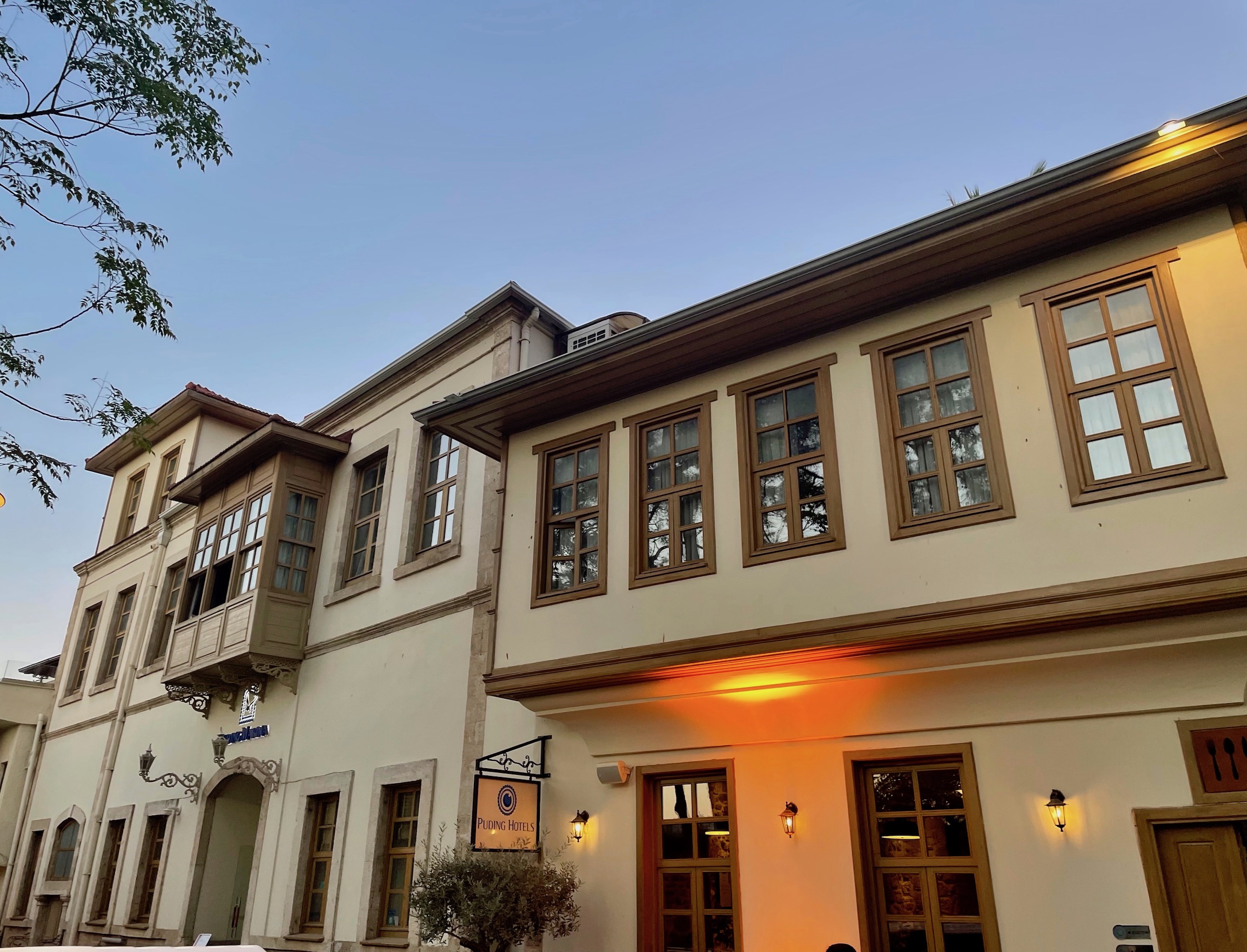
Our destination is the Puding Hotel which is a collection of six Ottoman mansions around a central courtyard in the oldest part of the city. Once again Adventures Abroad has done a great job in its hotel selections for this trip. This is room 634 which was very spacious and airy.
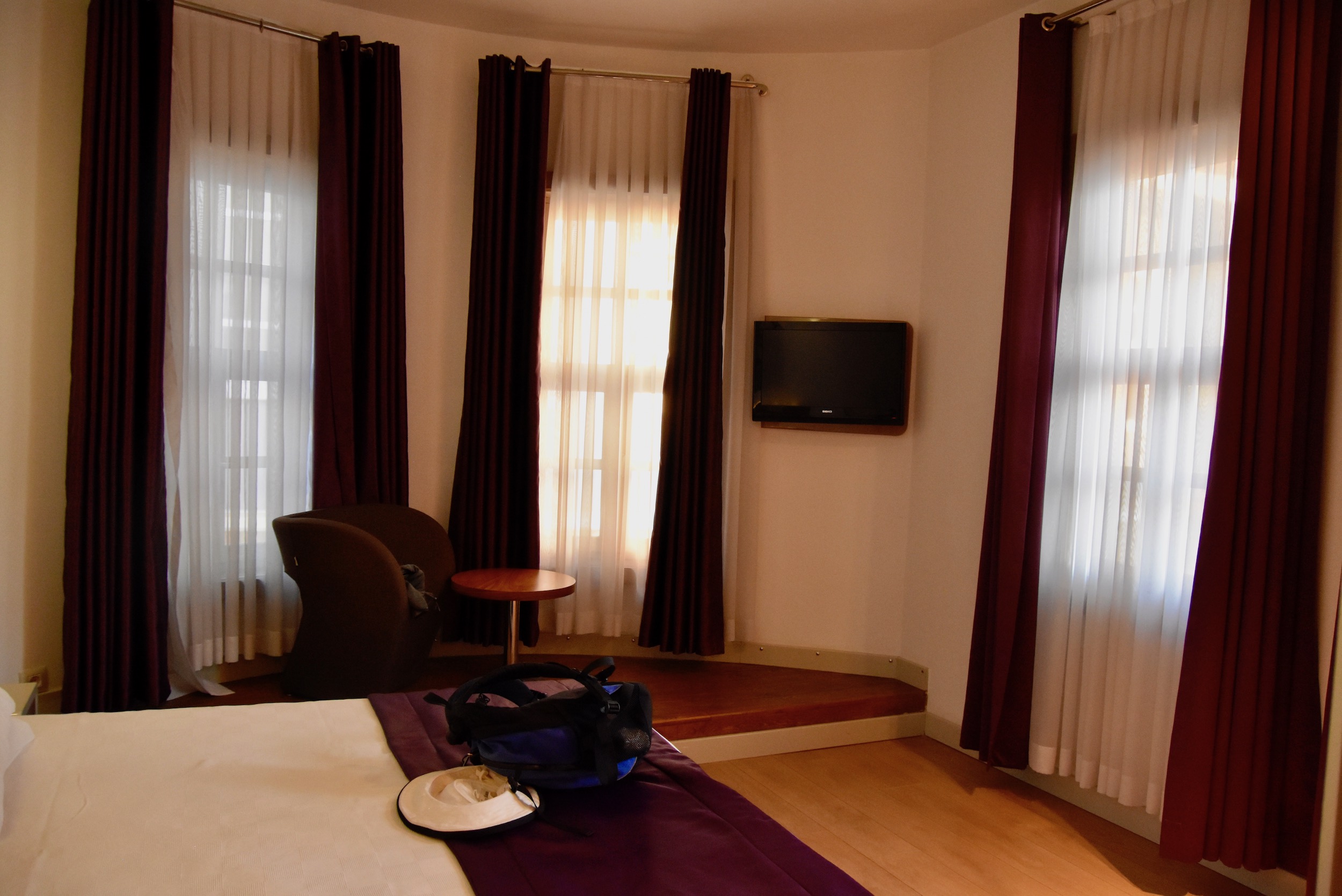
This is a view of the courtyard with swimming pool from our room. Antalya is well down the eastern Mediterranean and the weather is close to tropical so during our stay a number of the group opted for swimming and sun bathing.
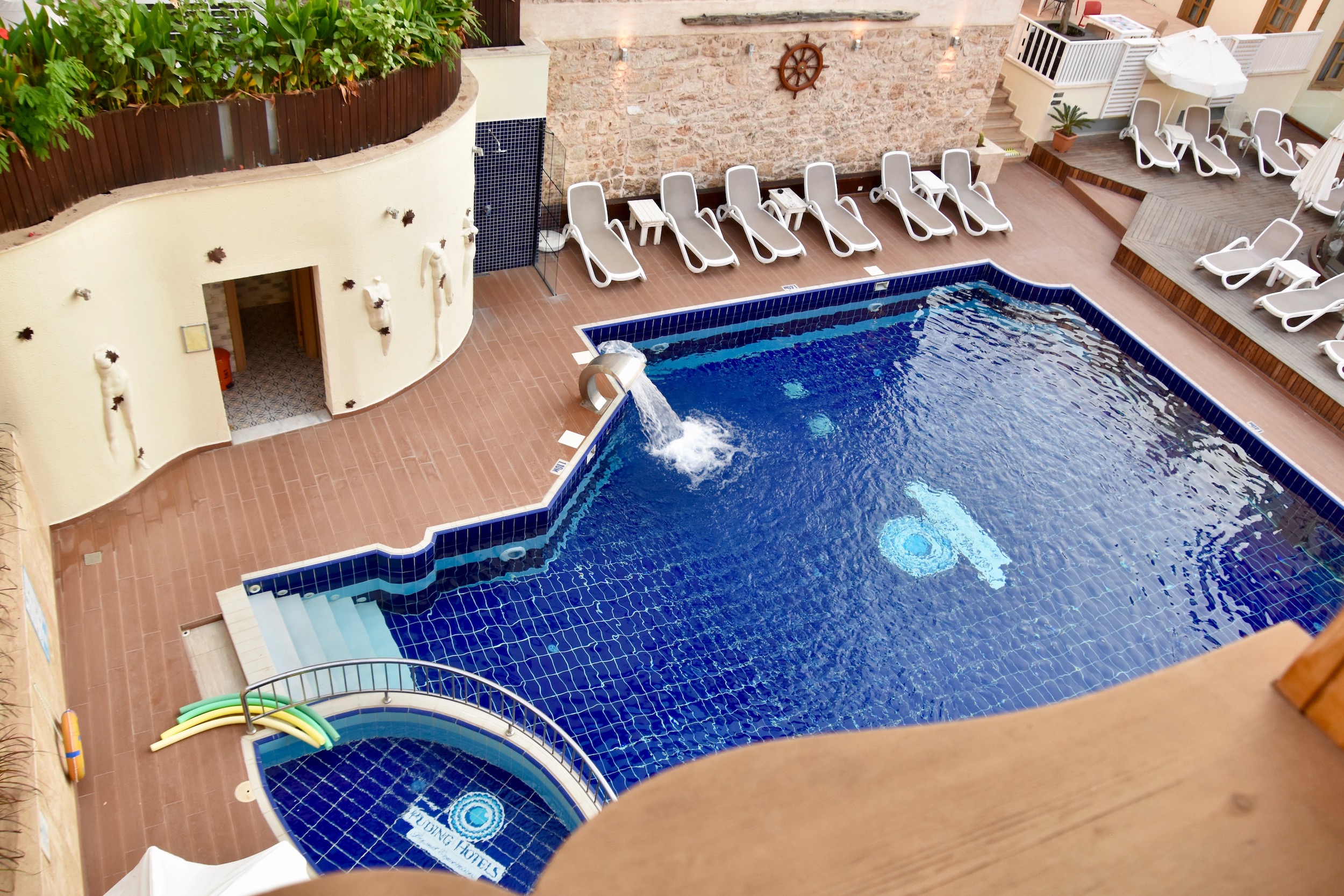
My preference was just to get out and walk through the historic district with no particular destination in mind. On a previous visit I did this early in the morning and found myself totally lost amid the jumble of lanes and alleys that are more like an urban maze than a normal street pattern. But if you are going to get lost then old Antalya is the place to do it. There’s nothing to worry about in terms of personal safety and eventually you will get back on track, even if you have to ask for directions.
In this lane the people on one side can literally hold hands with people on the other side, the upper stories are that close together.
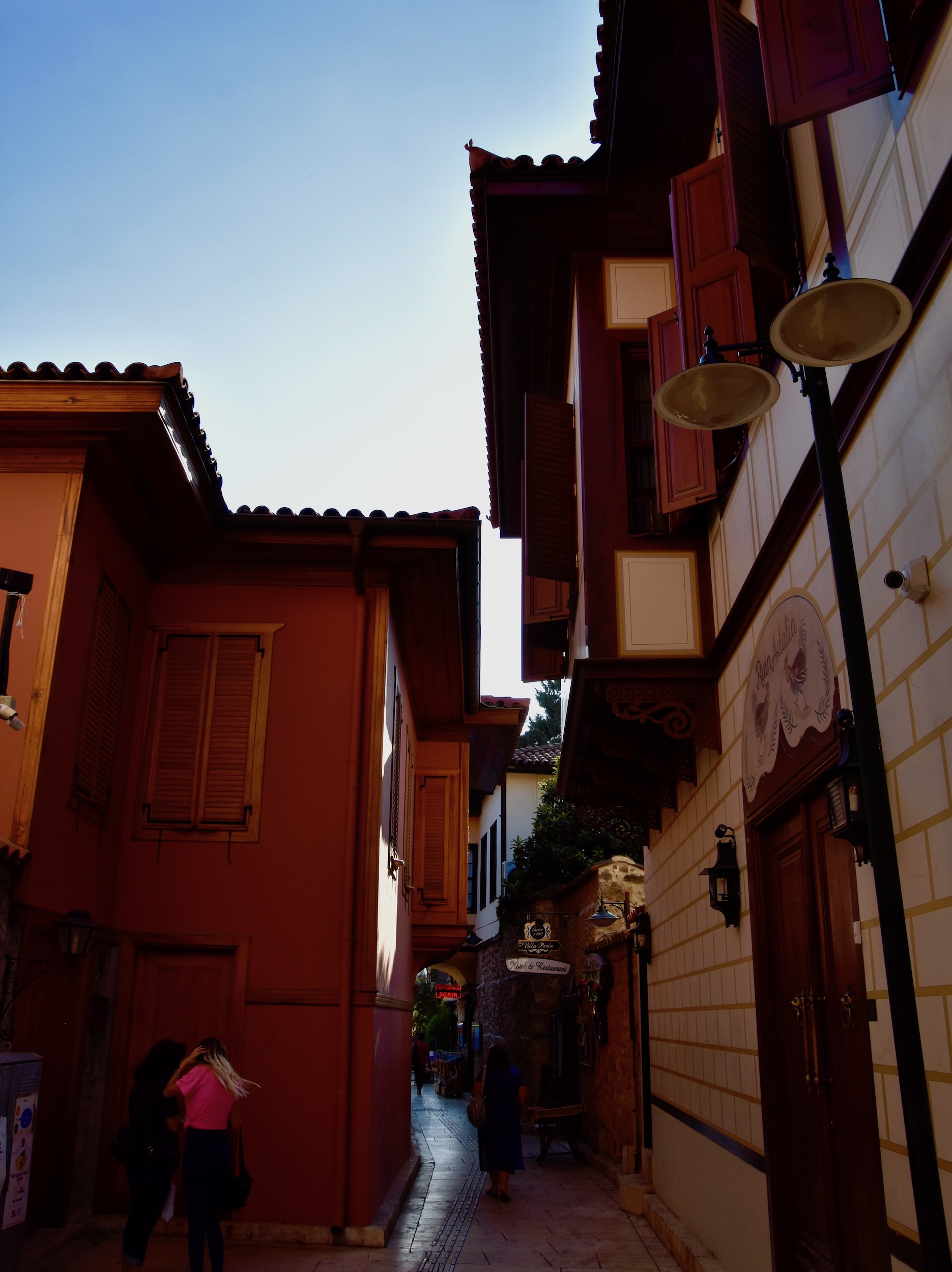
Here is a little sunnier streetscape.
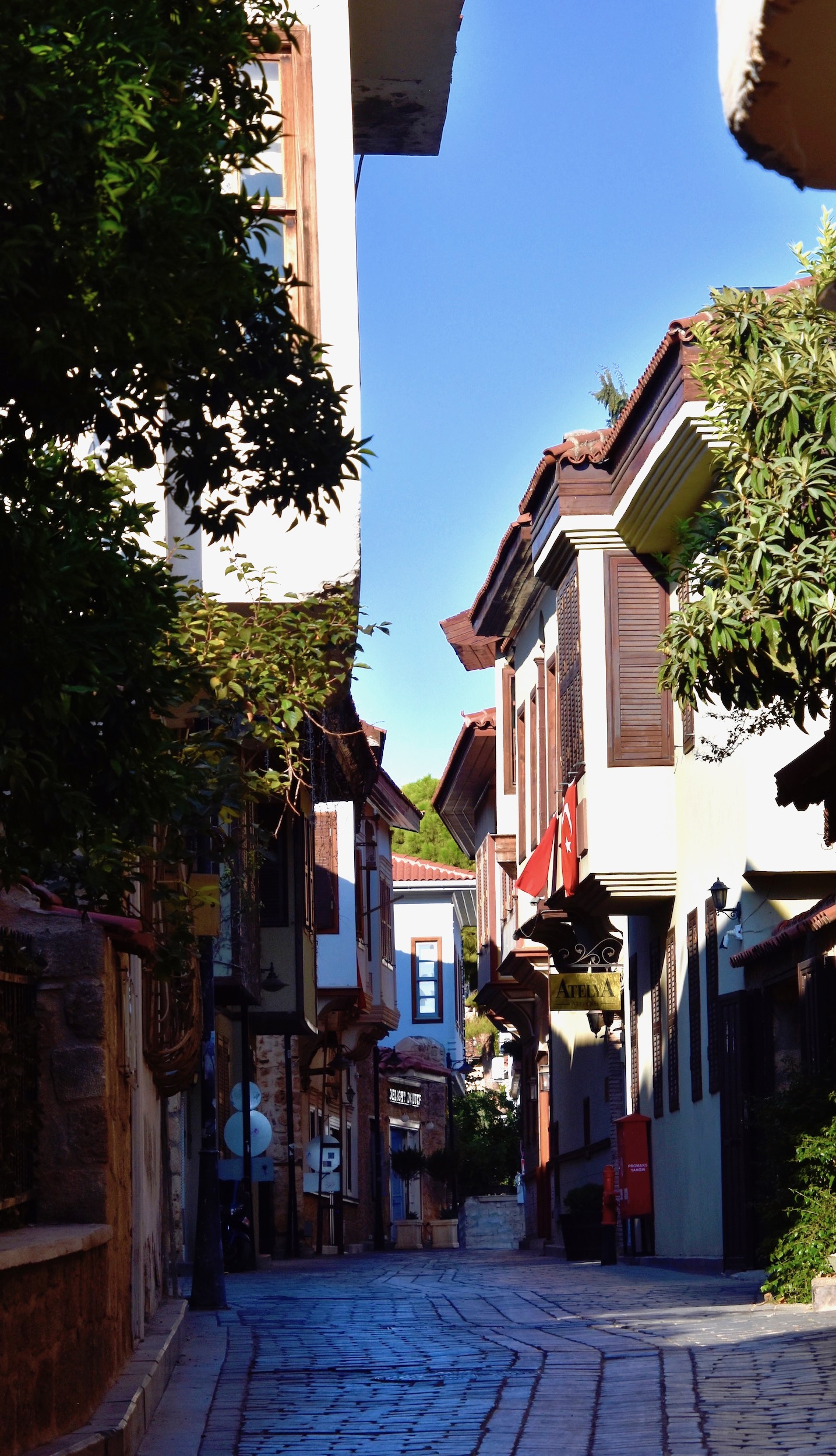
The historic district is also surprisingly green with an abundance of trees, shrubs and flowers that makes walking the area even more enjoyable.
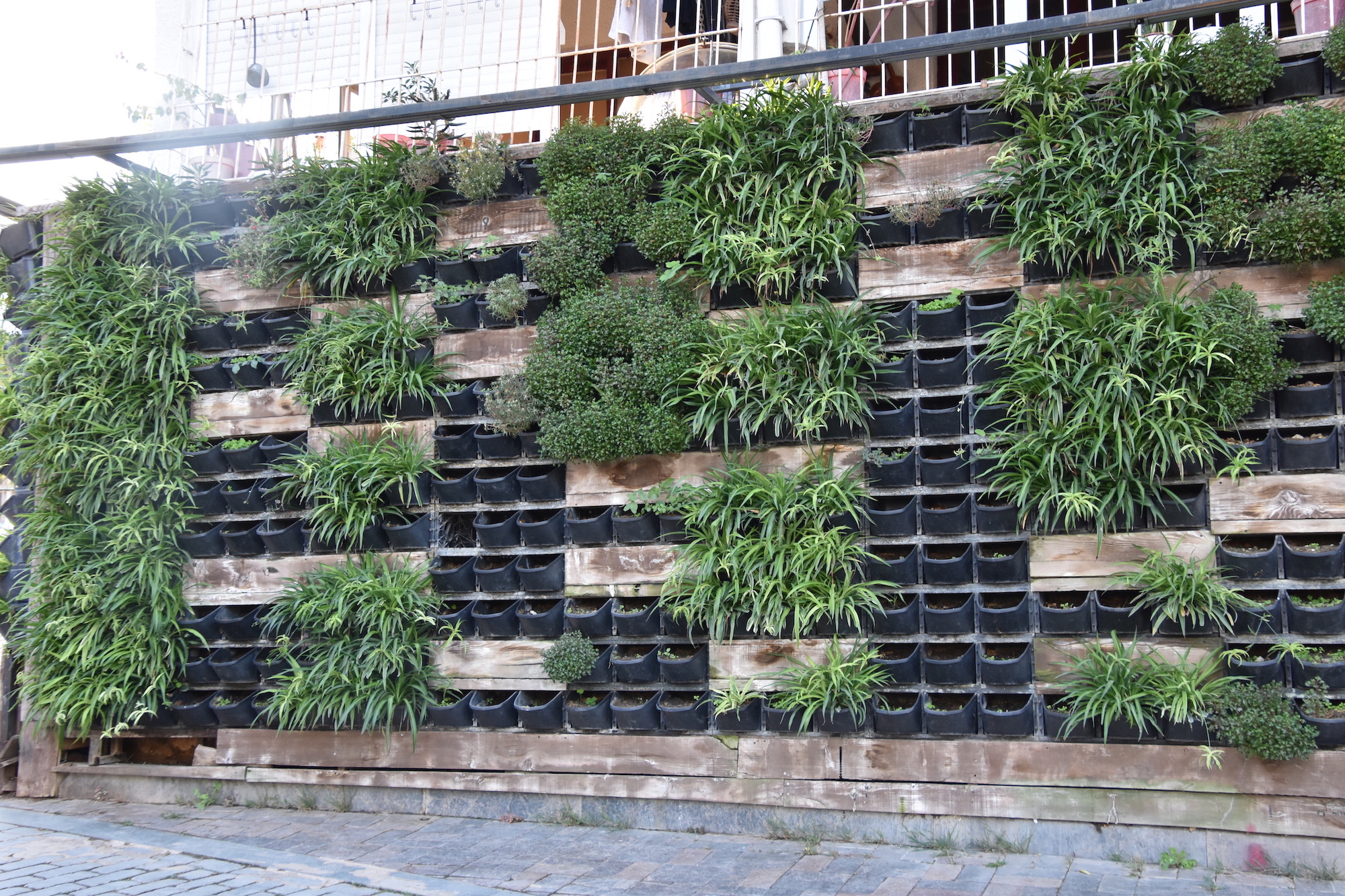
The entrance to (or exit from) the historic district of Antalya is through one of the city’s most famous landmarks, Hadrian’s Gate. From this perspective you can see that the older part of the city is literally about ten or twelve feet below the modern part.
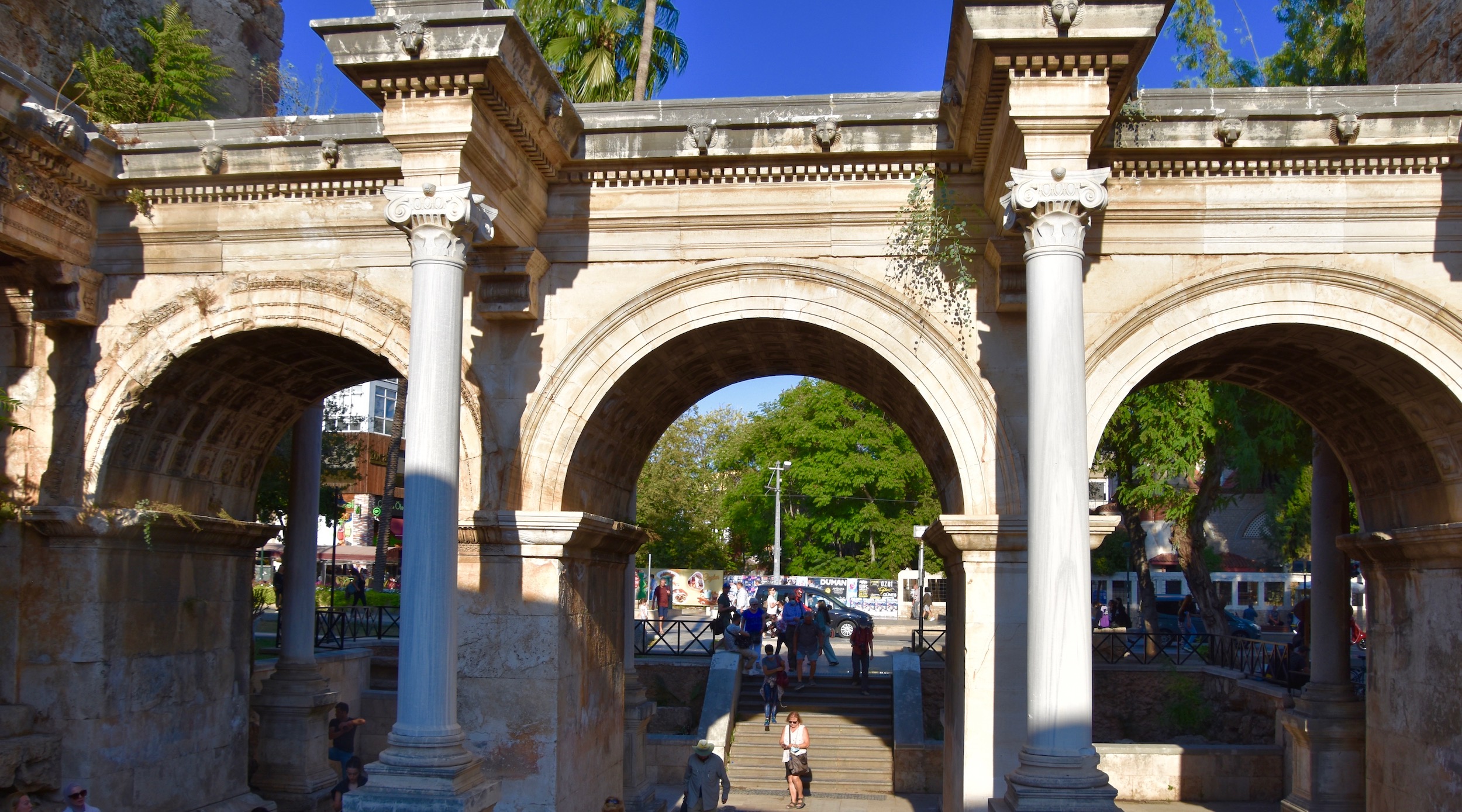
Briefly leaving the old district you come to the Antalya Mirador with this splendid view of the Taurus Mountains across the bay around which the city stretches.
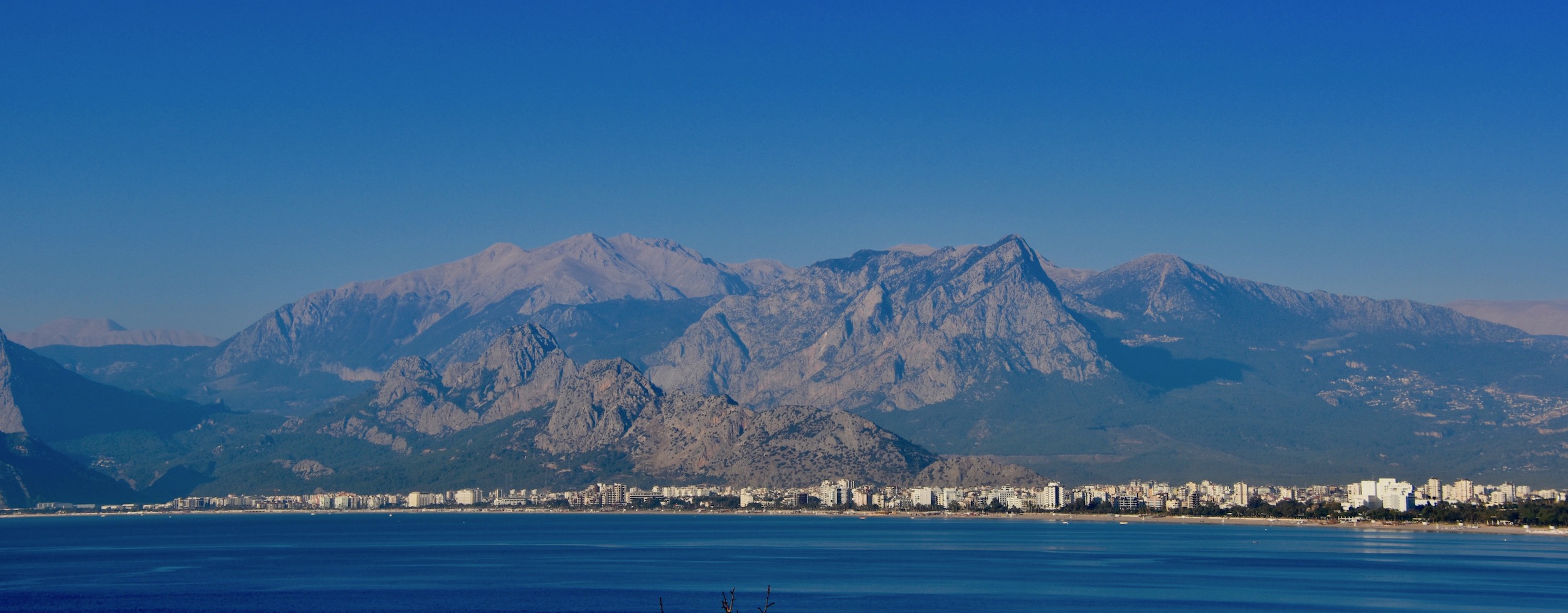
This is also where you will find the remnants of the 3rd century Roman fortress. It’s a good place to contemplate just how large the Roman Empire was at its zenith. A few years ago I was in northern England exploring the archaeological dig at the Roman settlement of Vindolanda, which was part of the Hadrian’s Wall fortifications. And today I’m looking at more works from Hadrian’s time. In case you are wondering that’s about 2,000 miles (3,300 kms.) and at Antalya we are nowhere near the eastern limits of the empire that stretched well over another 1,000 miles (1600 kms.) to the shores of the Persian Gulf.
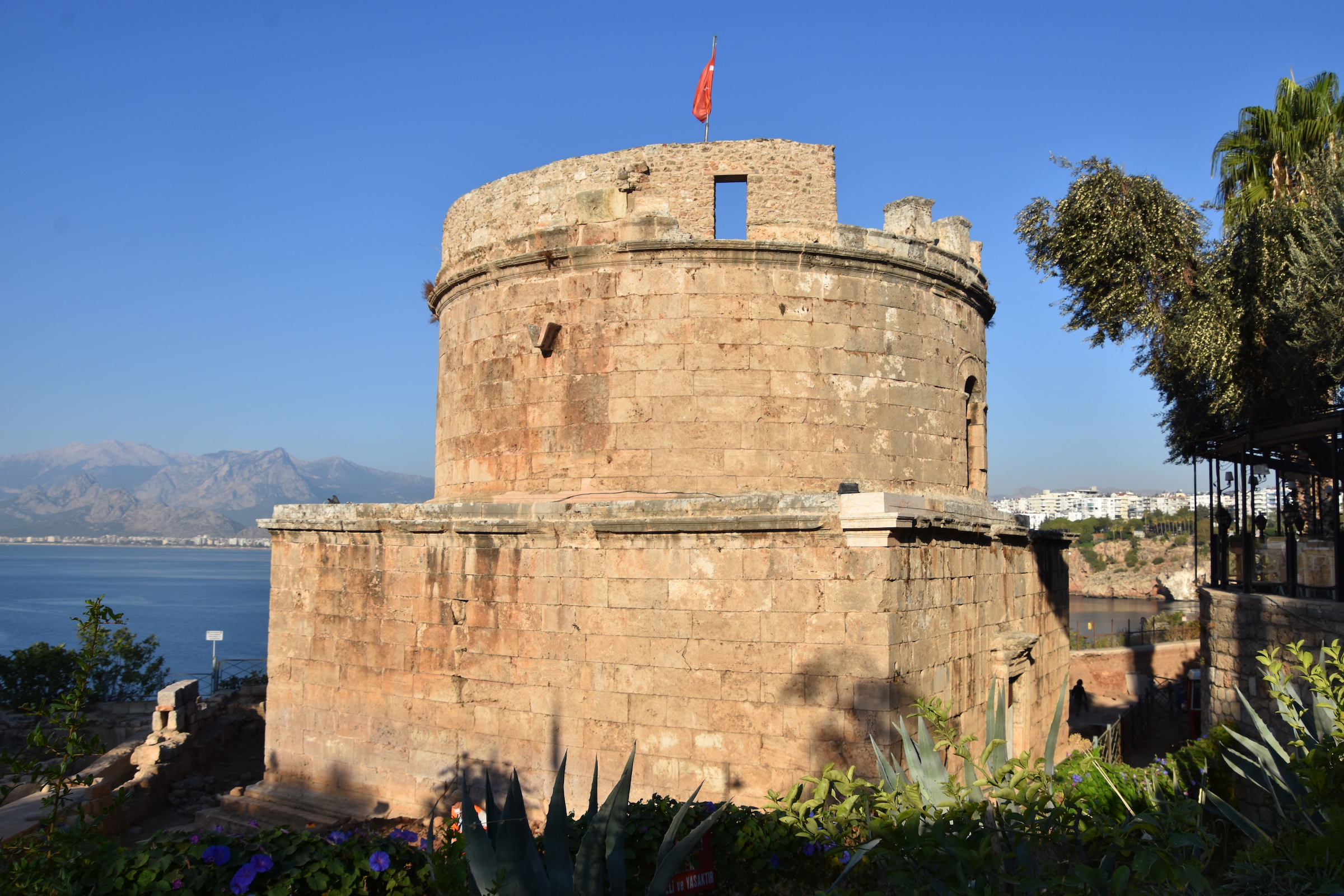
An interesting statue that I saw several places in Turkey is this stooped old man dressed as a traditional Turkish tea bearer that is actually a water fountain. This one was near the mirador.
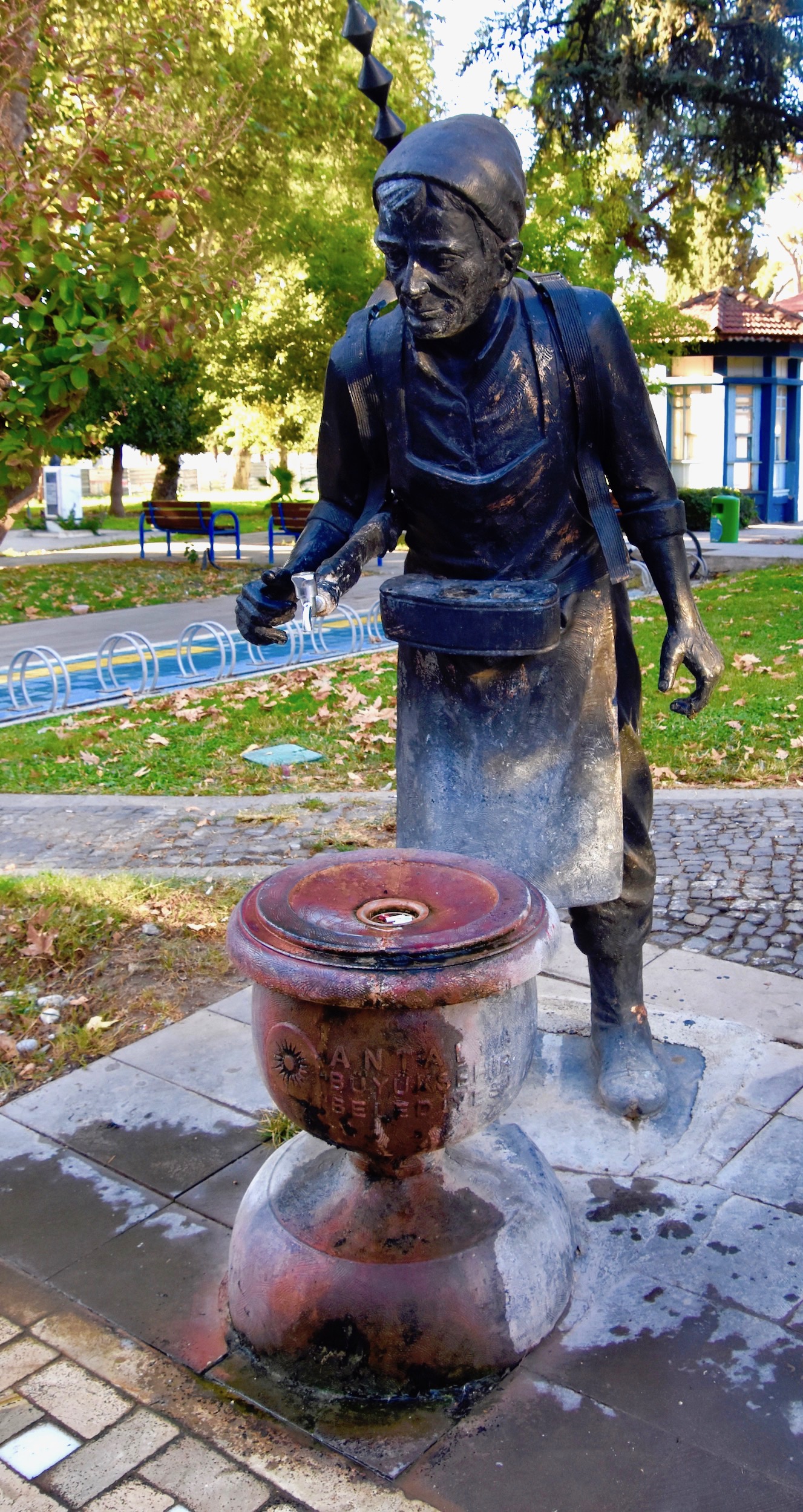
We used Antalya as a base to explore the archaeological sites of Aspendos and Perge which I will describe in upcoming posts. I will dedicate most of the rest of this post to the Antalya Archaeological Museum which as I noted is one of the best in Turkey.
Antalya Archaeological Museum
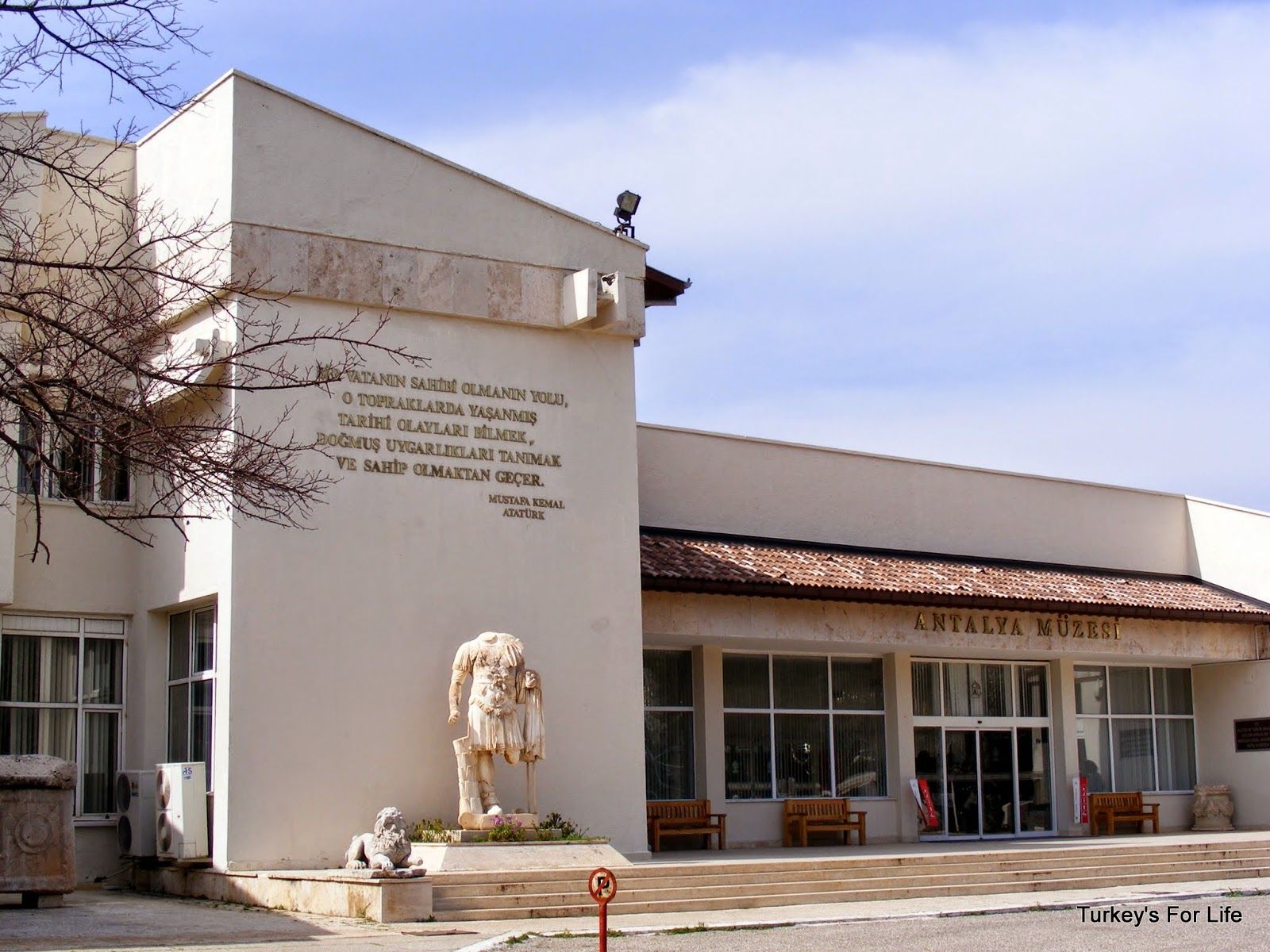
The Antalya Archaeological Museum was first established after WWI in response to the stripping of the Antalya area antiquities by the Italians who occupied the city from 1919-1922. It has occupied a number of sites over the years until this purpose built museum was opened in 1972. In 1985 it was completely reorganized along the lines of modern curatorship and today is considered a good example of how to explain the past to the present day folks from all over the world who come to visit. I certainly found it very well laid out and well signed in Turkish and English.
This is our guide Yasemin before a map of the Antalya area pointing out many of the ancient cities that once flourished in what was once the kingdom of Pamphylia which we entered at Kas. Pretty well all of the artifacts we will see come from this one small area of Turkey.
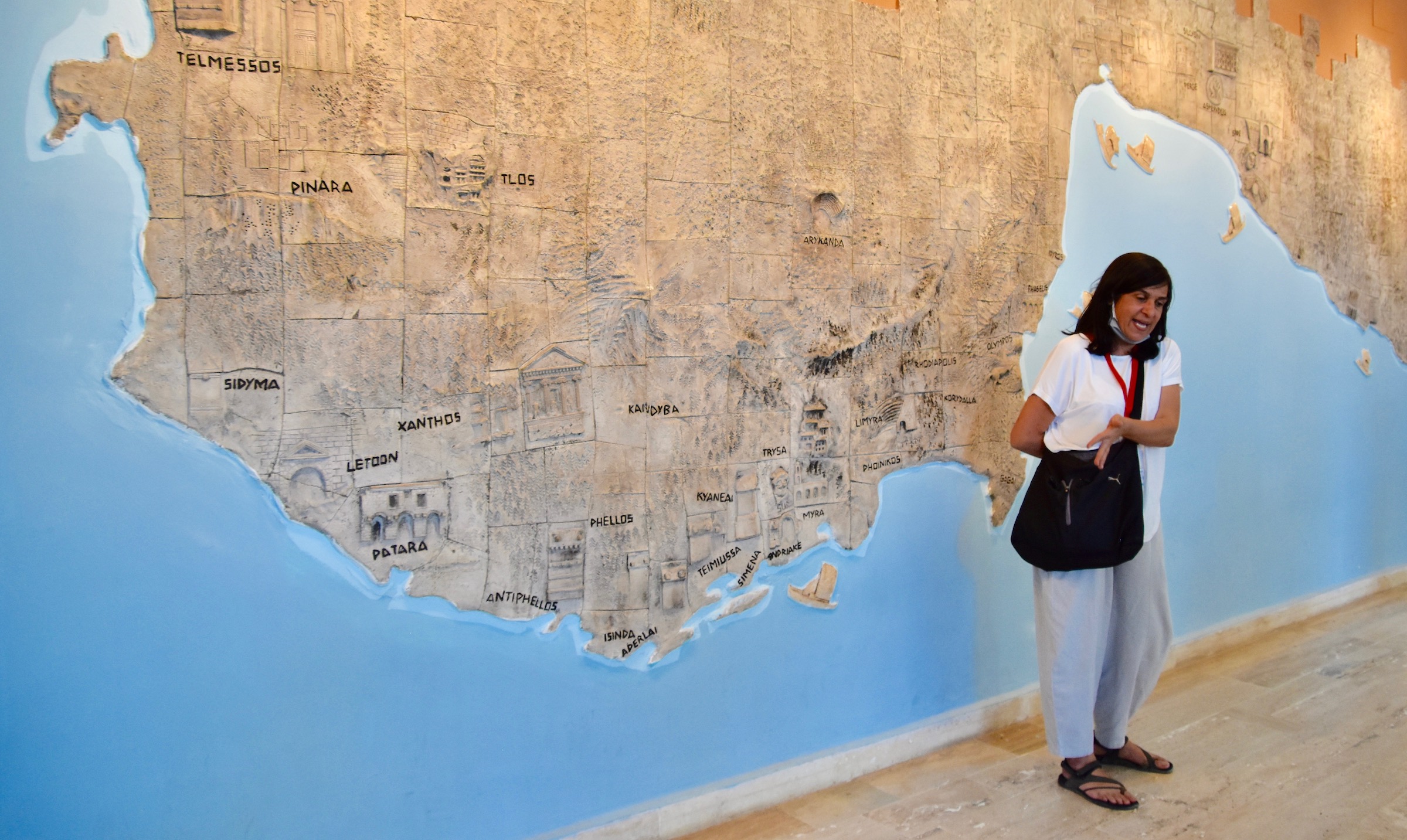
Each of places identified on the map has an accompanying model in this introductory room of the Antalya Archaeological Museum.
This one is of Myra and the rock cut tombs we saw there. Look closely and you can also see a couple of the stand alone ogival tombs we saw in Kas and Kekova and the theatre masks we saw at the Theatre of Myra.
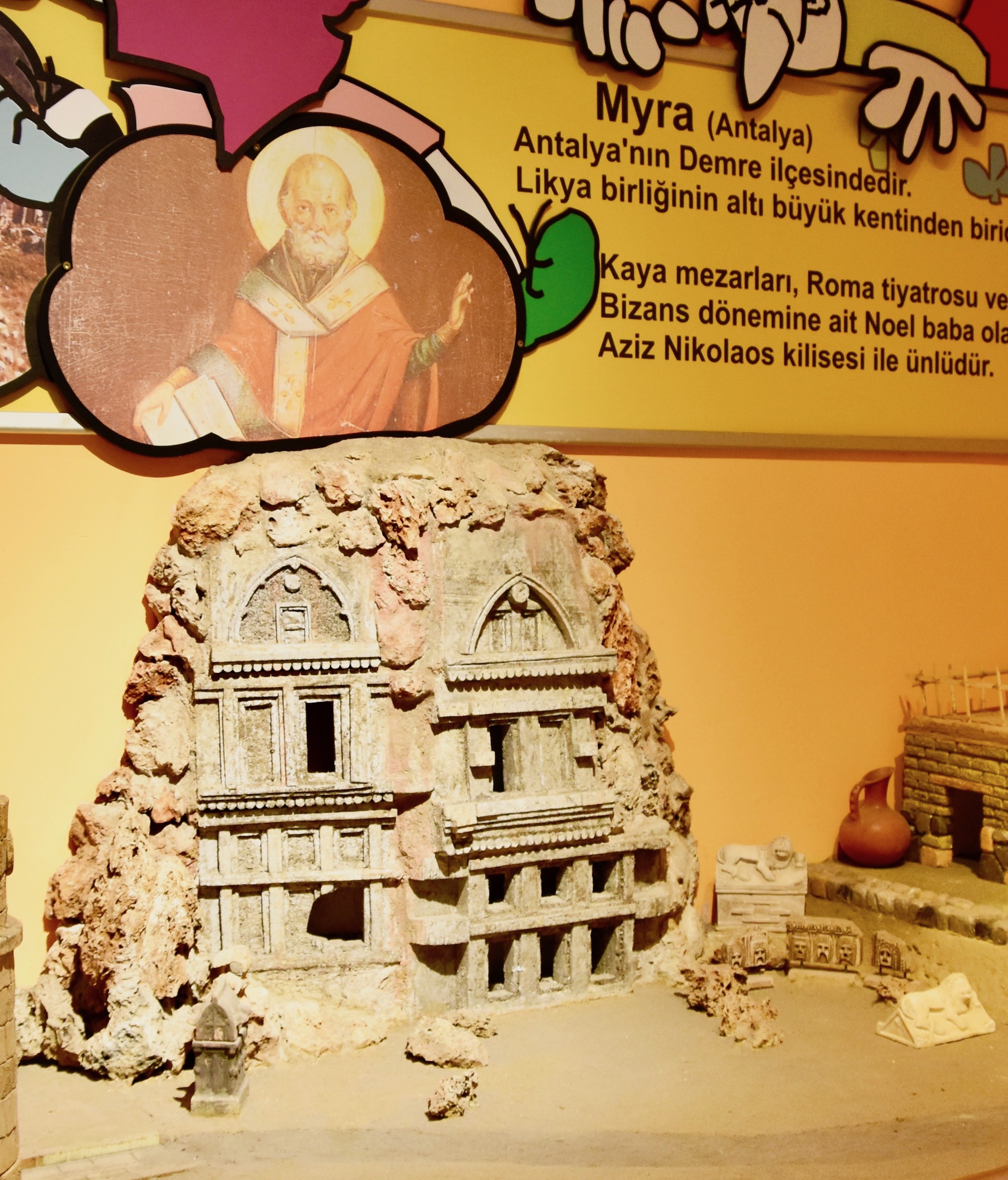
This is a model of the great Theatre of Aspendos which we will be seeing shortly.
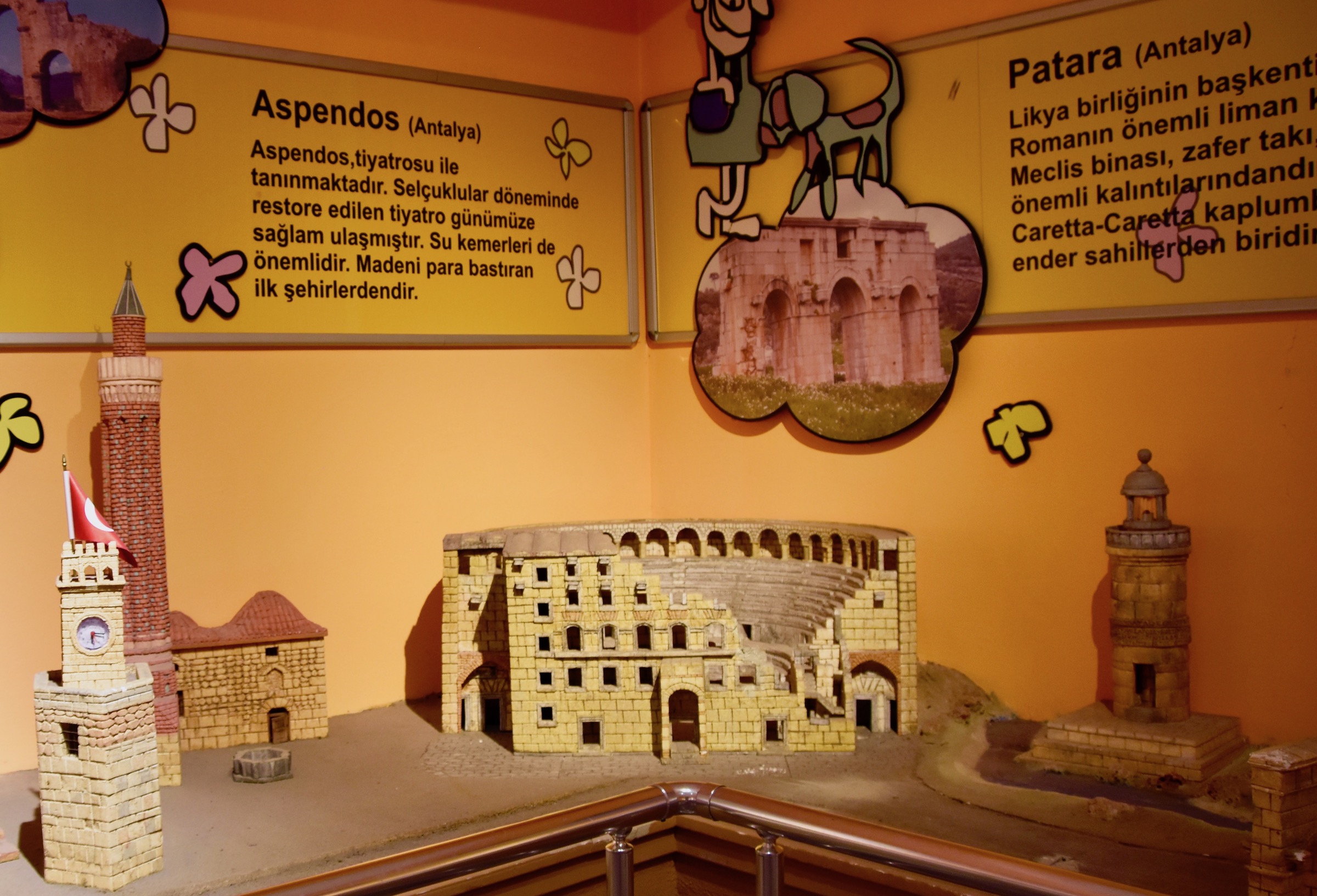
And this is the city of Perge, capital of Pamphylia which is also on our agenda.
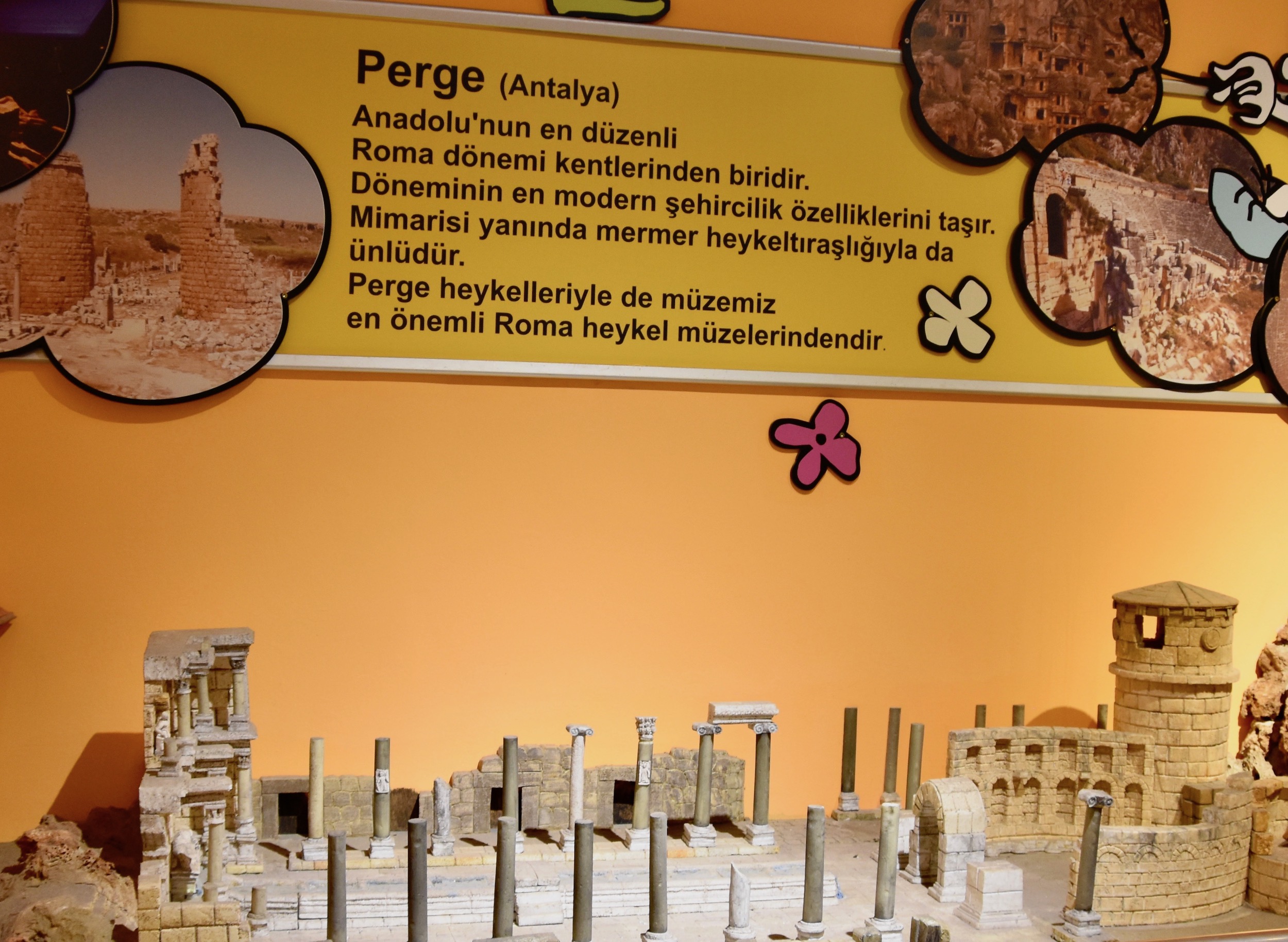
I thought these models were a great way to get started and get a picture of the places from where the artifacts were discovered.
After this introduction Yasemin let us explore at our own leisure and believe me, there was a hell of a lot to see, only a fraction of which I have included in this post.
We start well before any of the three cities modelled above were founded, as far back as the 9th century BCE with these figures from what is commonly referred to as the Geometric Age. It was a period when Greece and its Anatolian colonies were just emerging from the so-called Dark Age that followed the collapse of the Mycenaean civilization around 1100 BCE.
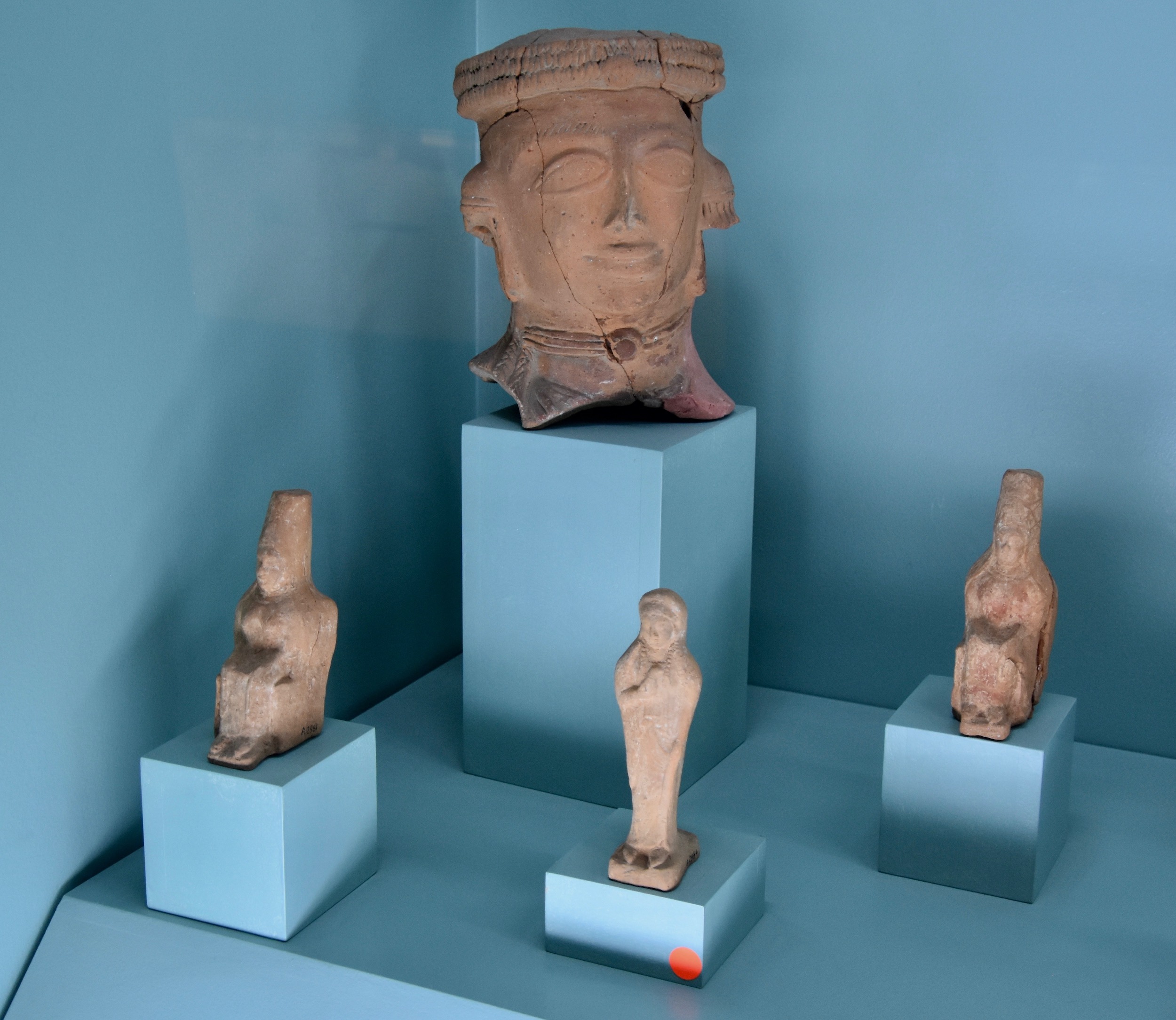
The Geometric Period was followed by the Archaic Period which lasted until 480 BCE and saw the wide expansion of Greek colonies throughout the Mediterranean and the development of the Greek city state. The pottery on display from this period in the Antalya Archaeological Museum is exquisite. This is the black figure style that is believed to have originated in Corinth and spread out from there. Instead of the abstract figures of the Geometric Age we now see very detailed and realistic depictions of real and mythological scenes.
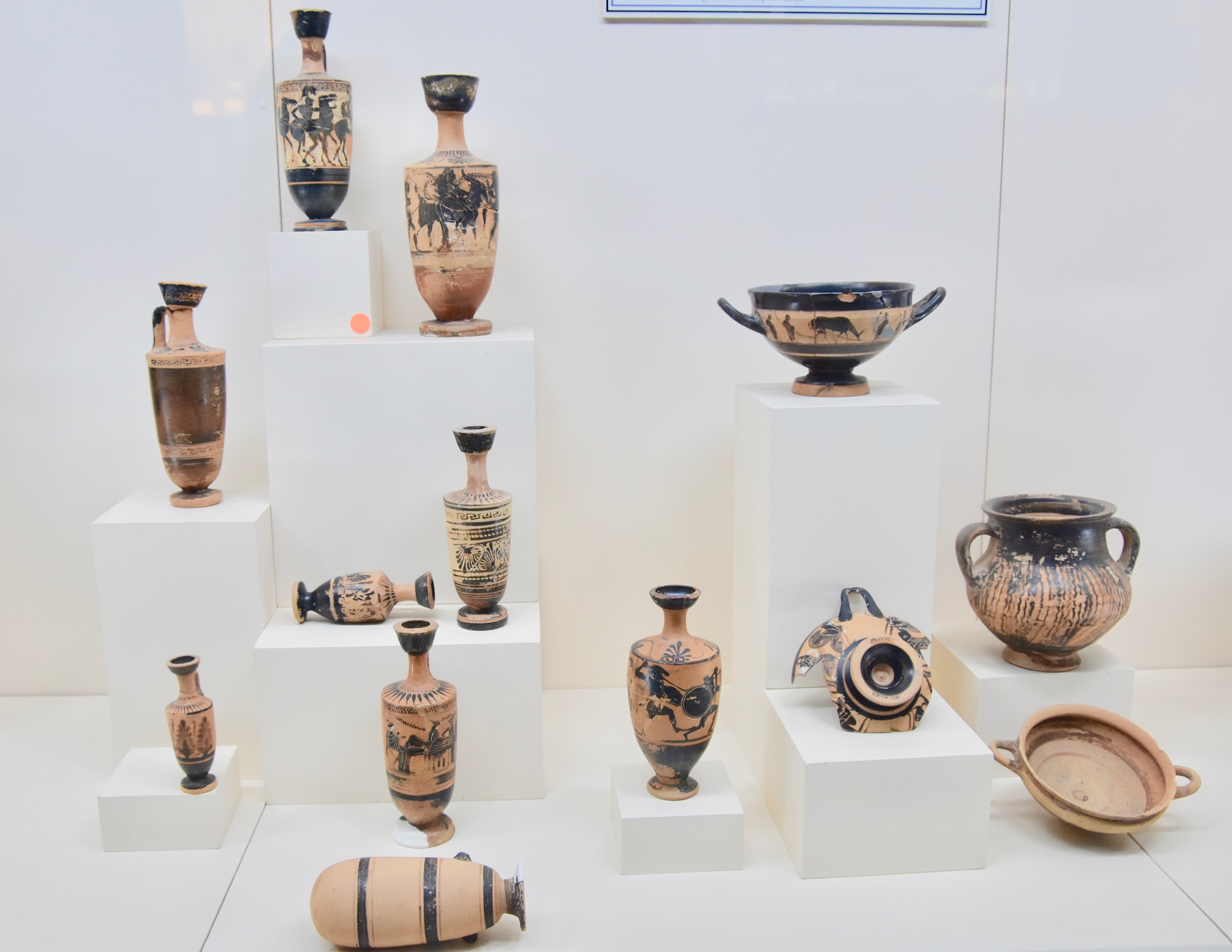
The Classic Period followed the Archaic and the red figure style of pottery developed in Athens is considered by many to be the epitome of ceramic art anywhere at any time and I am one of them.
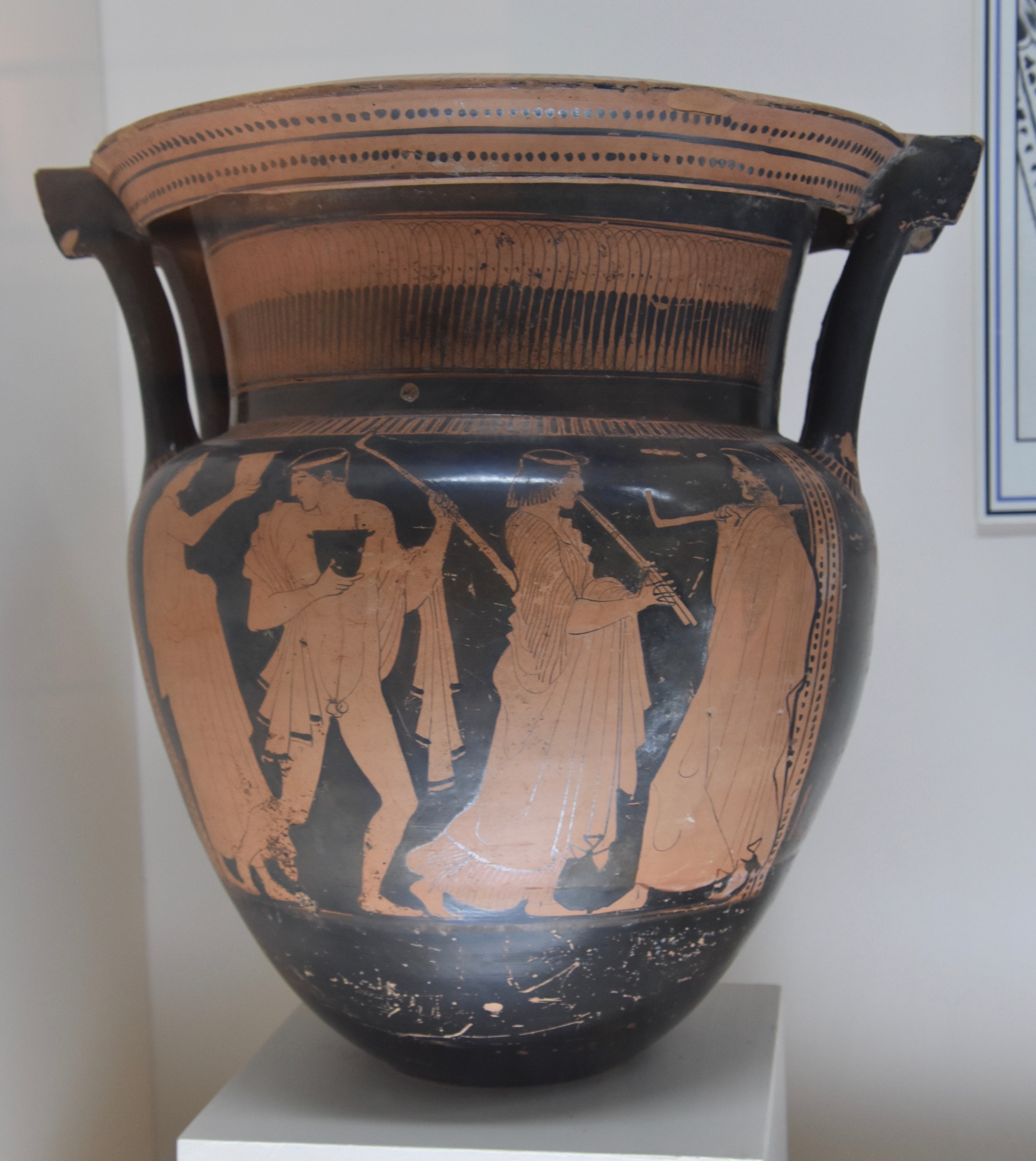
Whenever I see great pieces of red figure pottery and the complex themes that play out on them I cannot help but think back to Keats’ Ode on A Grecian Urn and the wonderment he found in the looking at them as well. This krater with its central figure playing the aulos is a very common theme and brings to mind two lines from that immortal poem – Heard melodies are sweet, but those unheard are sweeter; therefore ye soft pipes, play on.
Next comes the Hellenistic Period which started after Alexander the Great’s death in 323 BCE and lasted until the Roman ascension usually considered to have been complete after the Battle of Actium in 31 BCE.
This is the sun god Helios, but I couldn’t get Lisa Simpson out of my head.
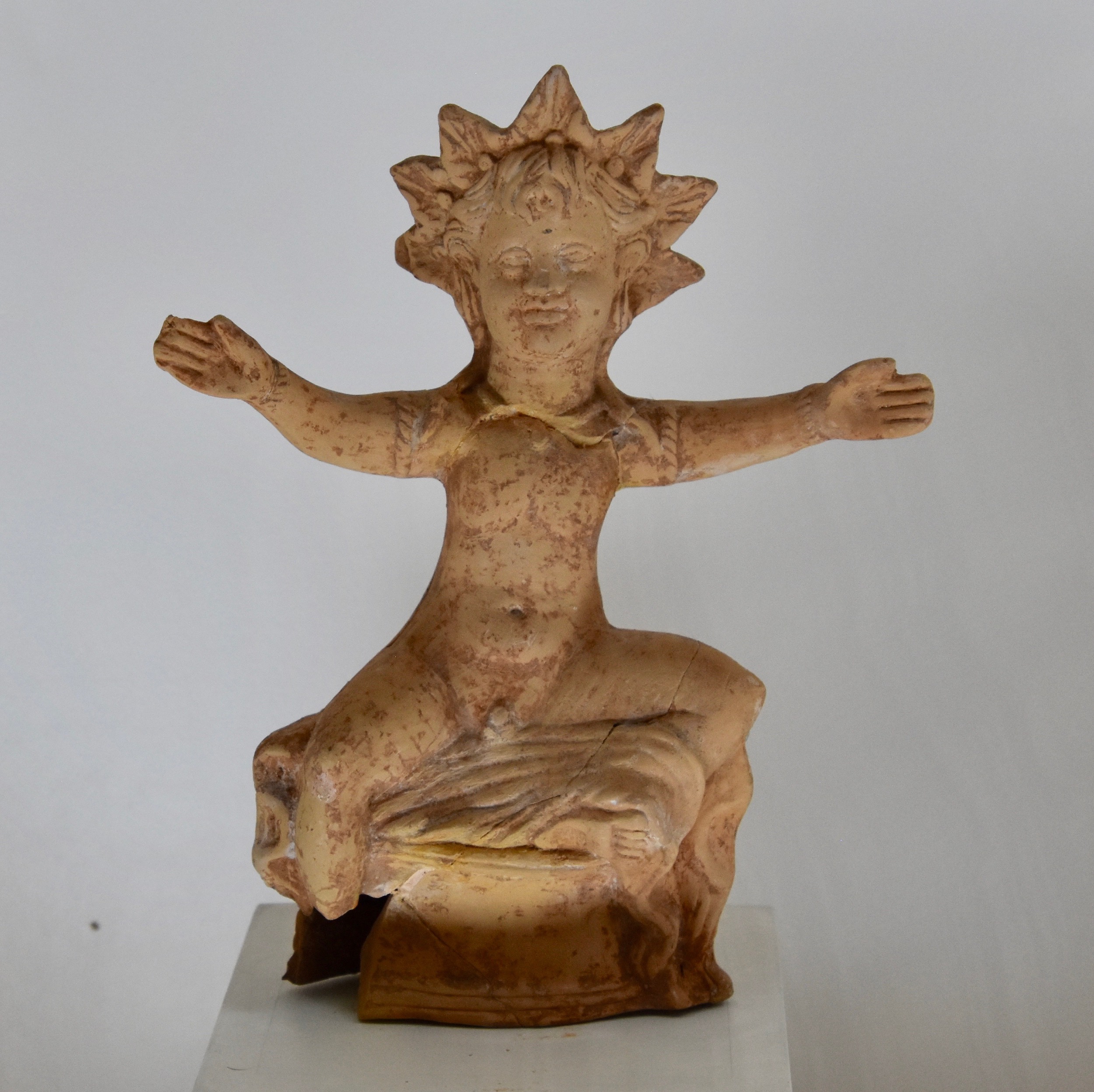
We now come to the Roman Era which is where the majority of the artifacts on display at the Antalya Archaeological Museum date from. This most unusual piece is from the city of Perge which was famous for its statuary. However, bronze statues from Perge were virtually unknown until 1971 when this sculpture of the very unusual god Attis was discovered. The cult of Attis dates as far back as 1250 BCE and originated in Turkey. By 450 BCE it had spread throughout much of the Greek world. There are many forms of this god, but most depict him as extremely handsome as this depiction most certainly is. What he is primarily known for is castrating himself, dying and being resurrected in a symbolic reference to the seasons. The unusual headwear is a Phrygian cap which is where the cult of Attis began. By the second century he was widely worshipped throughout much of the Roman Empire. I recall seeing a shrine to him in the Roman port of Ostia some years back. This is an amazing and unique artifact.
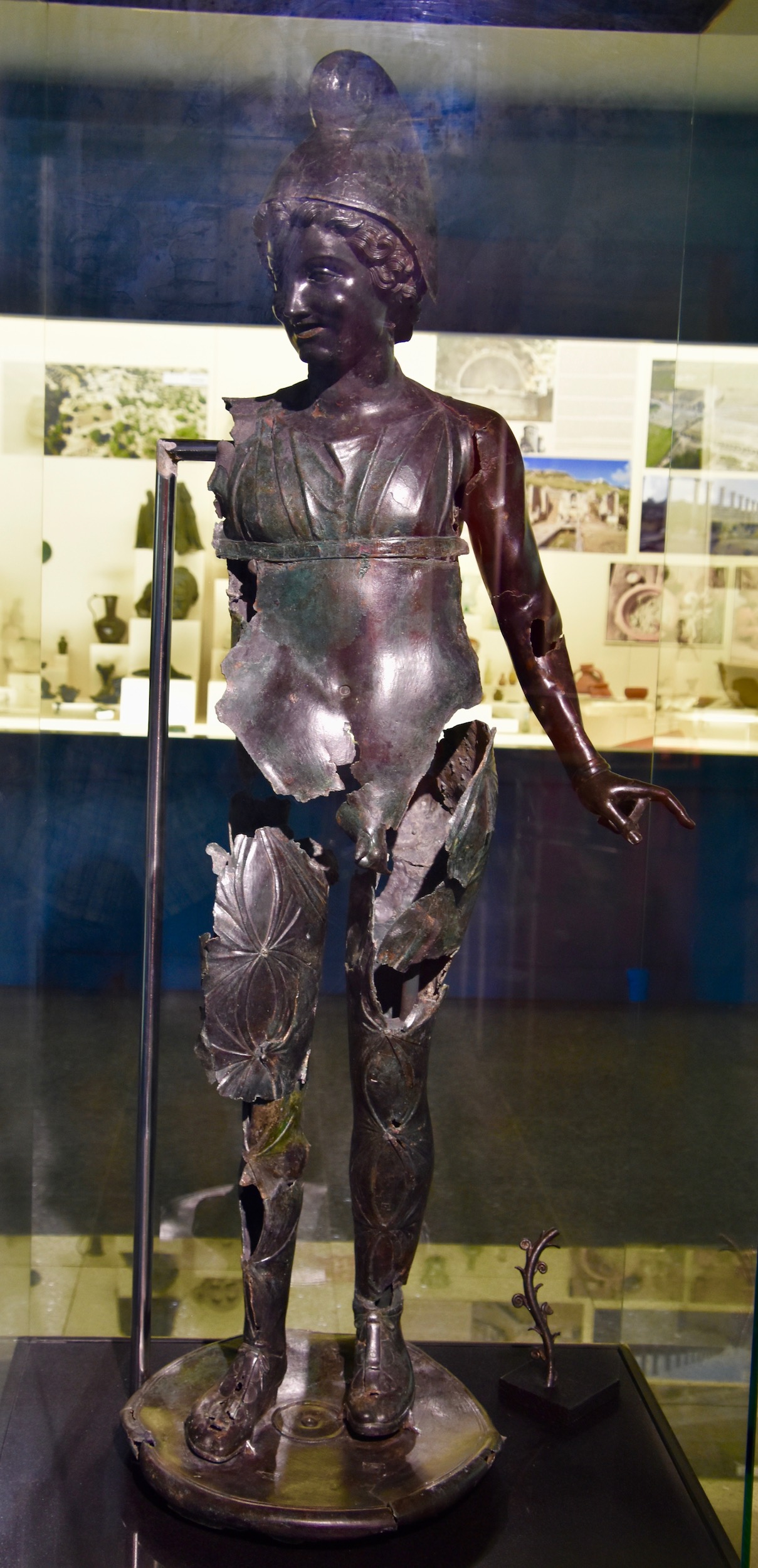
The chronological sequence continues with the Byzantine Era and this display of artifacts from the Basilica of St. Nicholas which we visited in Myra.
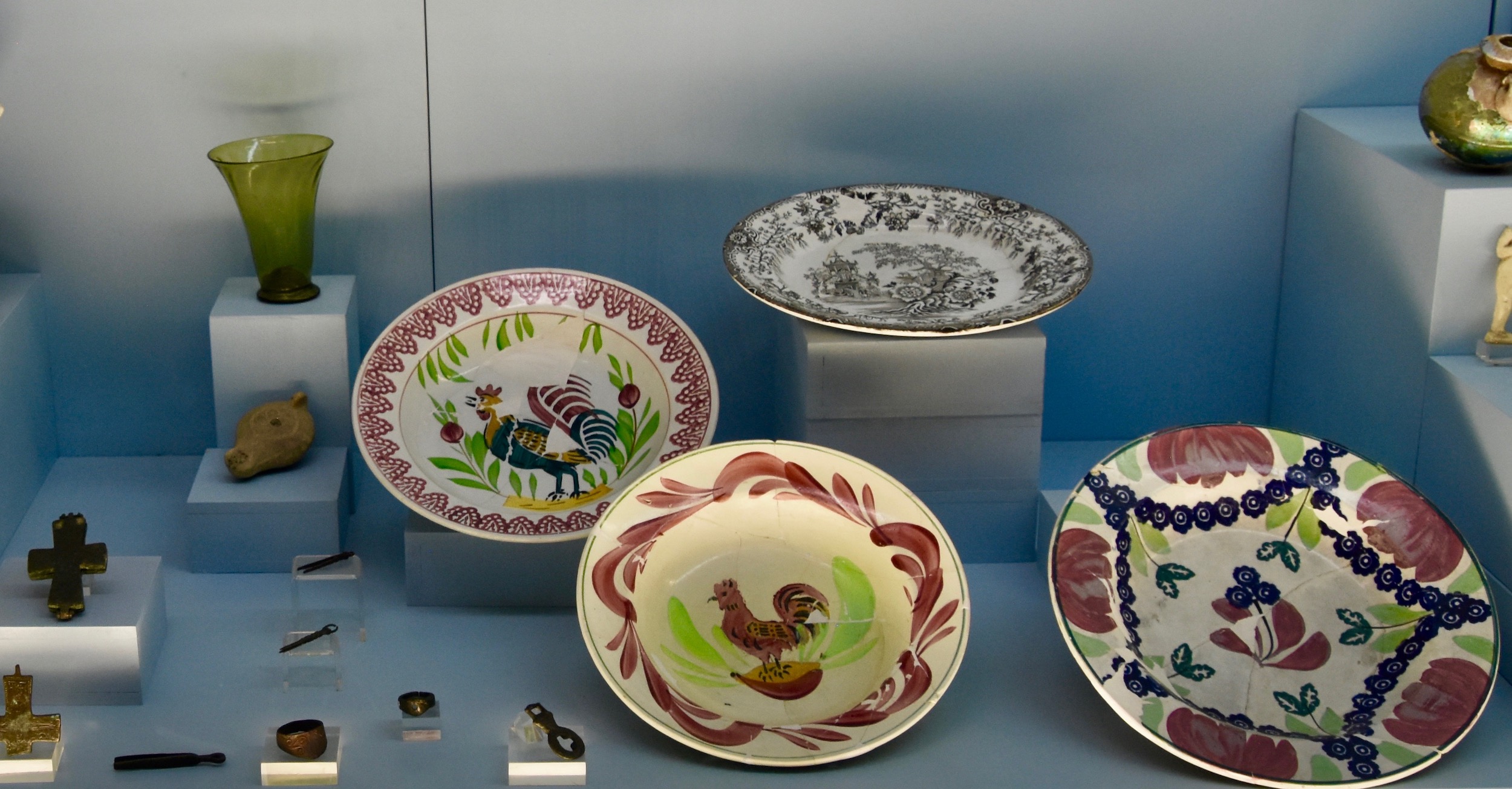
Now comes the hall of statues from Perge and they are simply amazing. Let’s start with this one of a dancing woman, which while quite fragmentary, still conveys the grace and fluidity of motion of a woman dancing to her own tune. This is one of the few statues on display in the Emporer’s Hall that does not depict a named person or god.
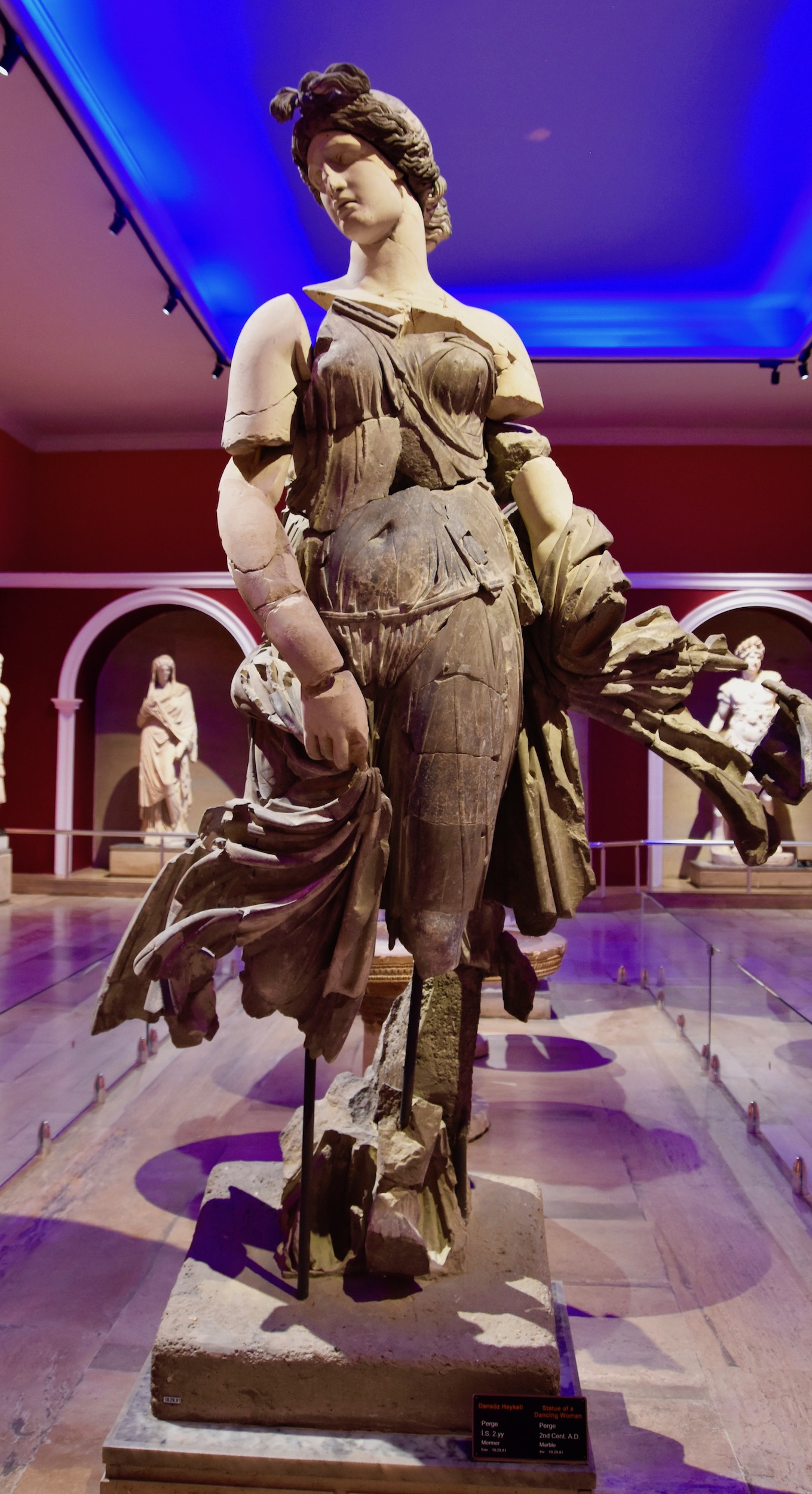
Next we have someone we are quite familiar with – our friend Emperor Hadrian who we have followed from Troy to Pergamon to Ephesus to Antalya and soon to Perge. We get to meet him in two different guises starting with this one which was based on a famous but now lost statue of the Trojan War hero Diomedes by the sculptor Kresilas done in about 450 BCE. Luckily for us copies of this statue were made of which the most famous is in the Glyptothek Museum in Munich. In turn Roman sculptors used the naked Diomedes theme to depict famous people of the day. On his head Hadrian is wearing the Corona Civica which was an honour given to Romans who had saved the lives of others. Nudity was not a big deal to the Greeks or Romans so they had no trouble being sculpted naked. In all likelihood it was prudish Christians who castrated him as they were wont to do.
All I can say is that thank God this trend of nude statues has died out with modern leaders. Can you imagine a naked statue of the Former Guy? Or even the present guy?
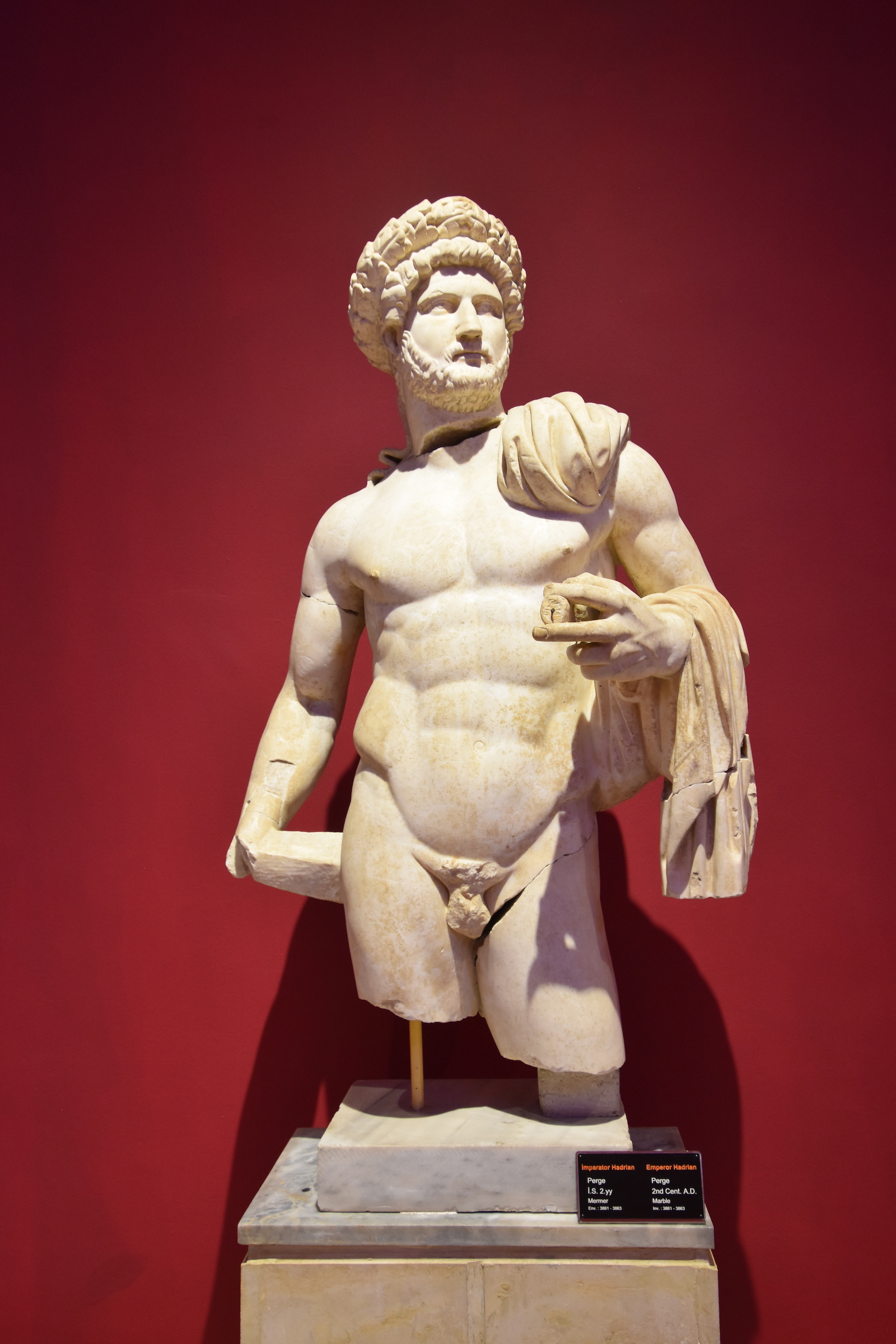
To me this is one of the best full length statues of a Roman Emperor I have ever seen. It is just plain powerful and you feel it as you stand before it. It is what is referred to as a ‘cuirassed statue’ meaning the figure is depicted in ceremonial leather armour with a very elaborate breast plate. The Romans were the masters of this style.
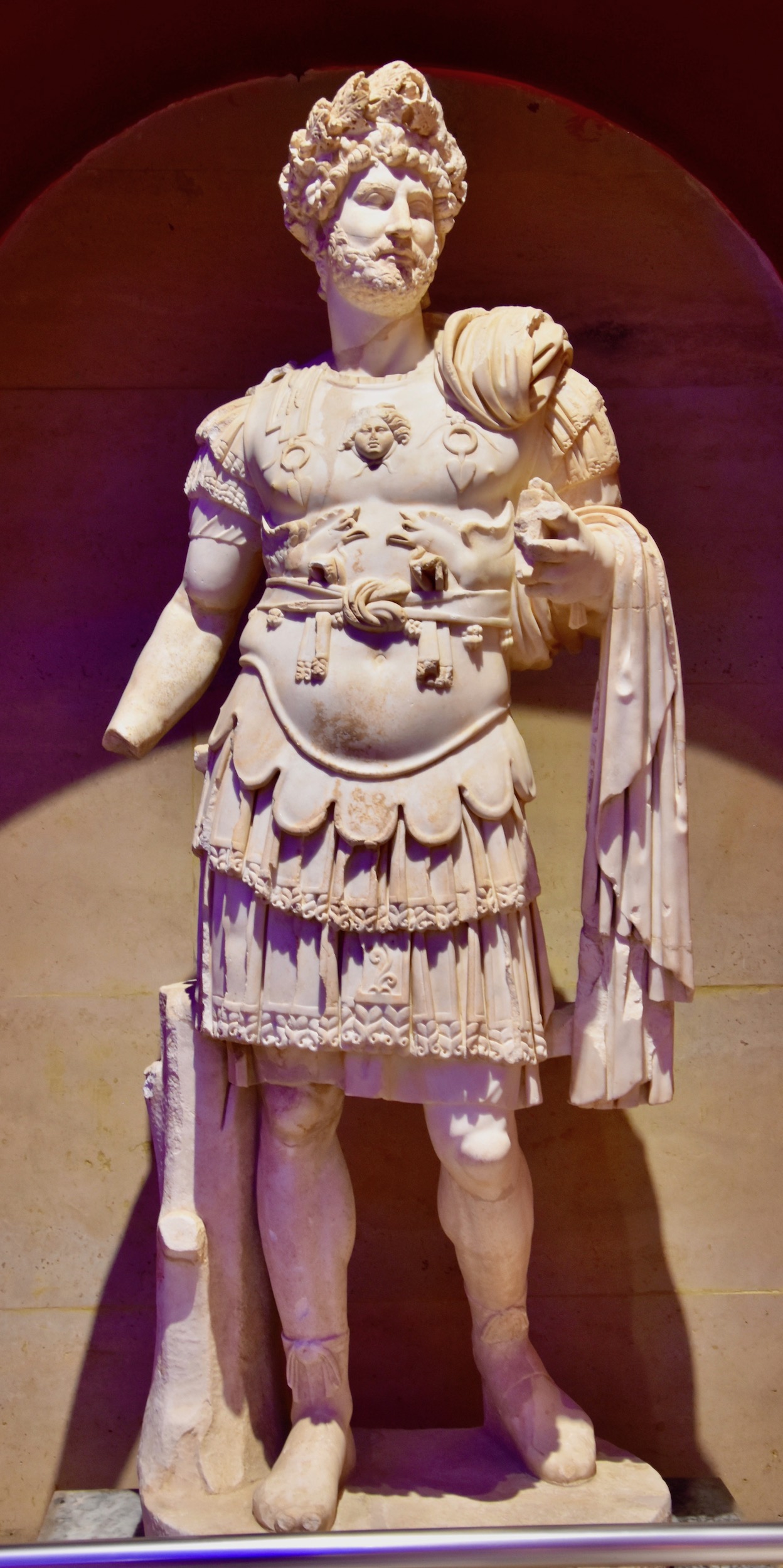
Hadrian’s predecessor was Trajan who ruled from 98 to 117 and is considered to be one of the greatest Roman emperors. This is his cuirassed statue from Perge with that image of Medusa on the breast plate that we saw in Didyma. I’ve seen the woman at his feet described as an Amazon representing Asia Minor, but Amazons had one breast cut off to facilitate their fighting ability and this woman has both. However, whoever it is clearly represents subjugation.
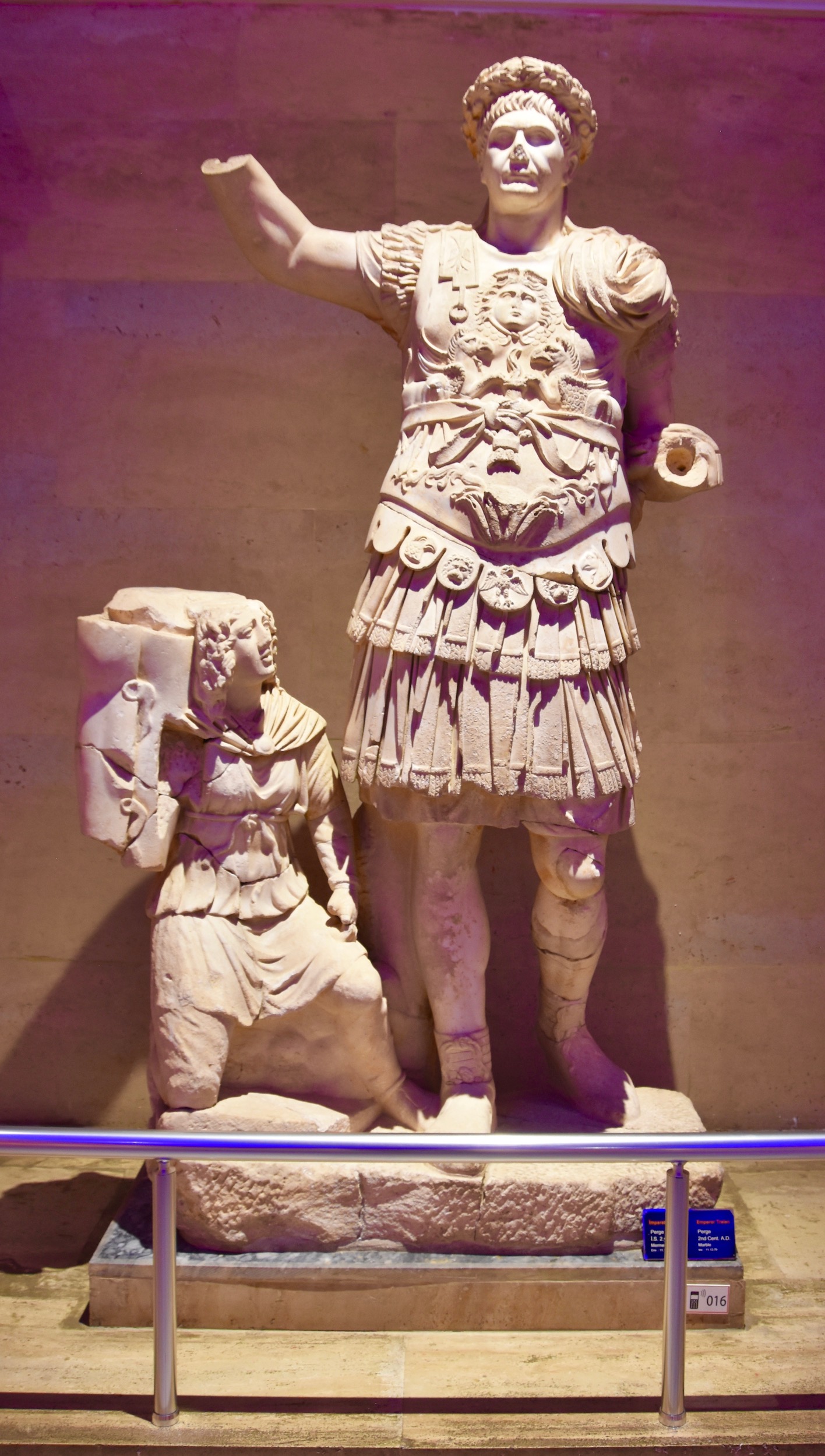
The last of the Roman emperors on display is Septimius Severus who seized power in 193 and held it until 211 when he died in modern day York after getting sick during an attempt to conquer Caledonia (Scotland). However before that he conducted a number of wars against the Parthians in modern day Syria and Iraq. He would almost certainly have travelled through Perge during these campaigns as we will see a nymphaeon (fountain) dedicated to him when we visit the site.
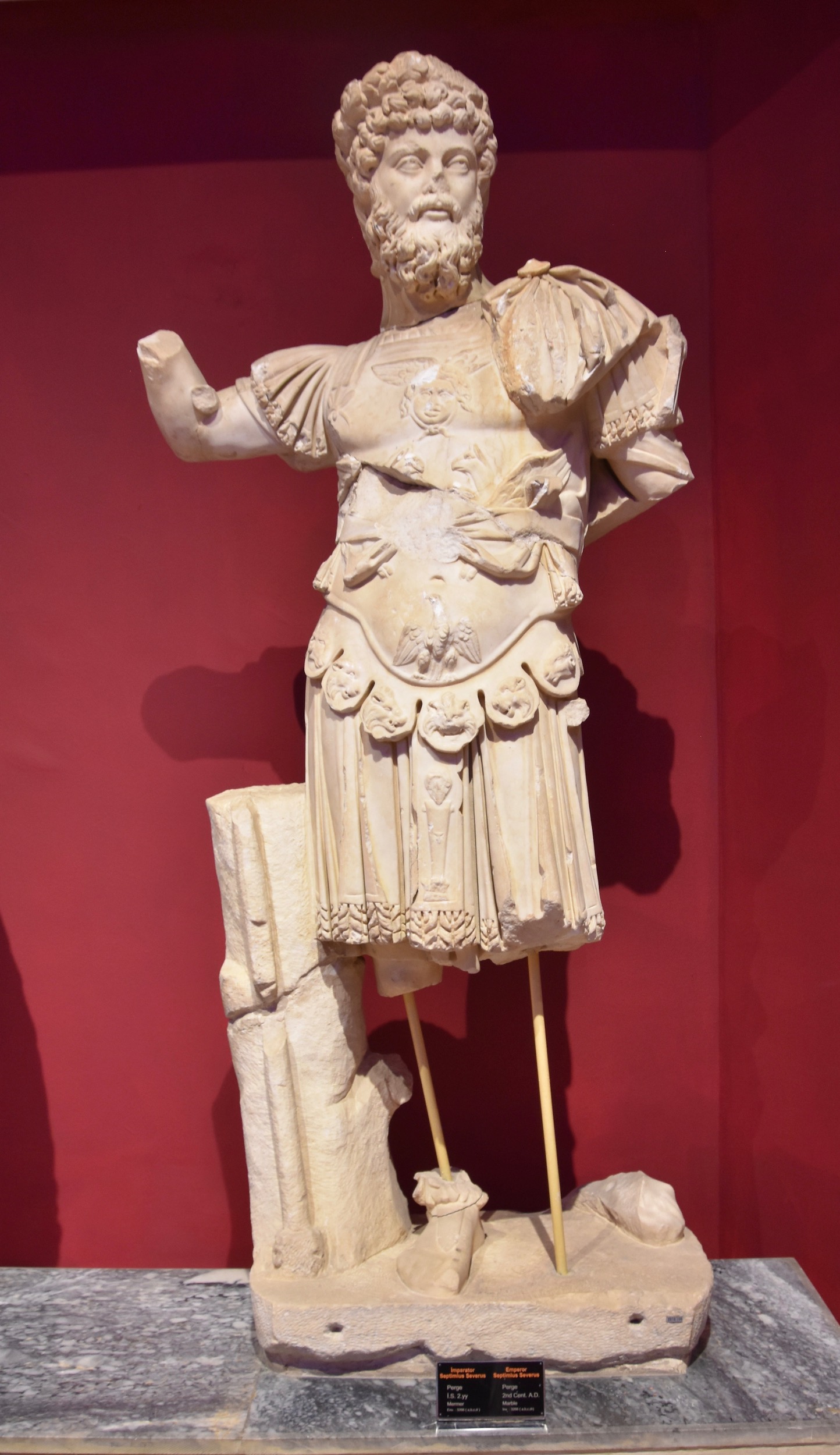
The next figure is the only one with a direct connection to Perge, Plancia Magna who in the same tradition that we saw at Ephesus was a private citizen who was a major benefactor to her city. The brilliant statues of Hadrian were probably commissioned by her. Too bad she didn’t get a better sculptor for her own figure.
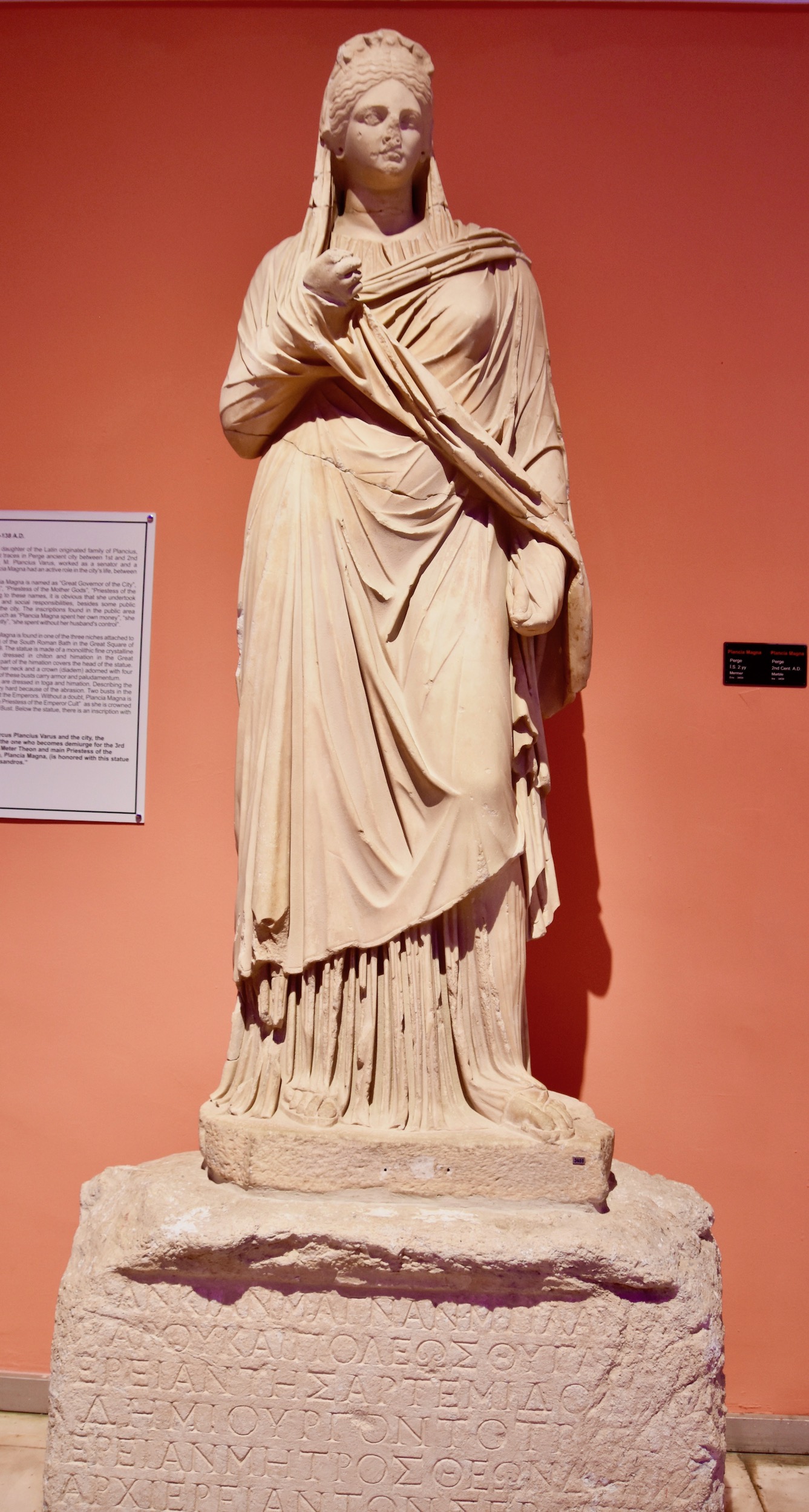
We now leave Emperor’s Hall and make our way down this passageway lined with more statues.
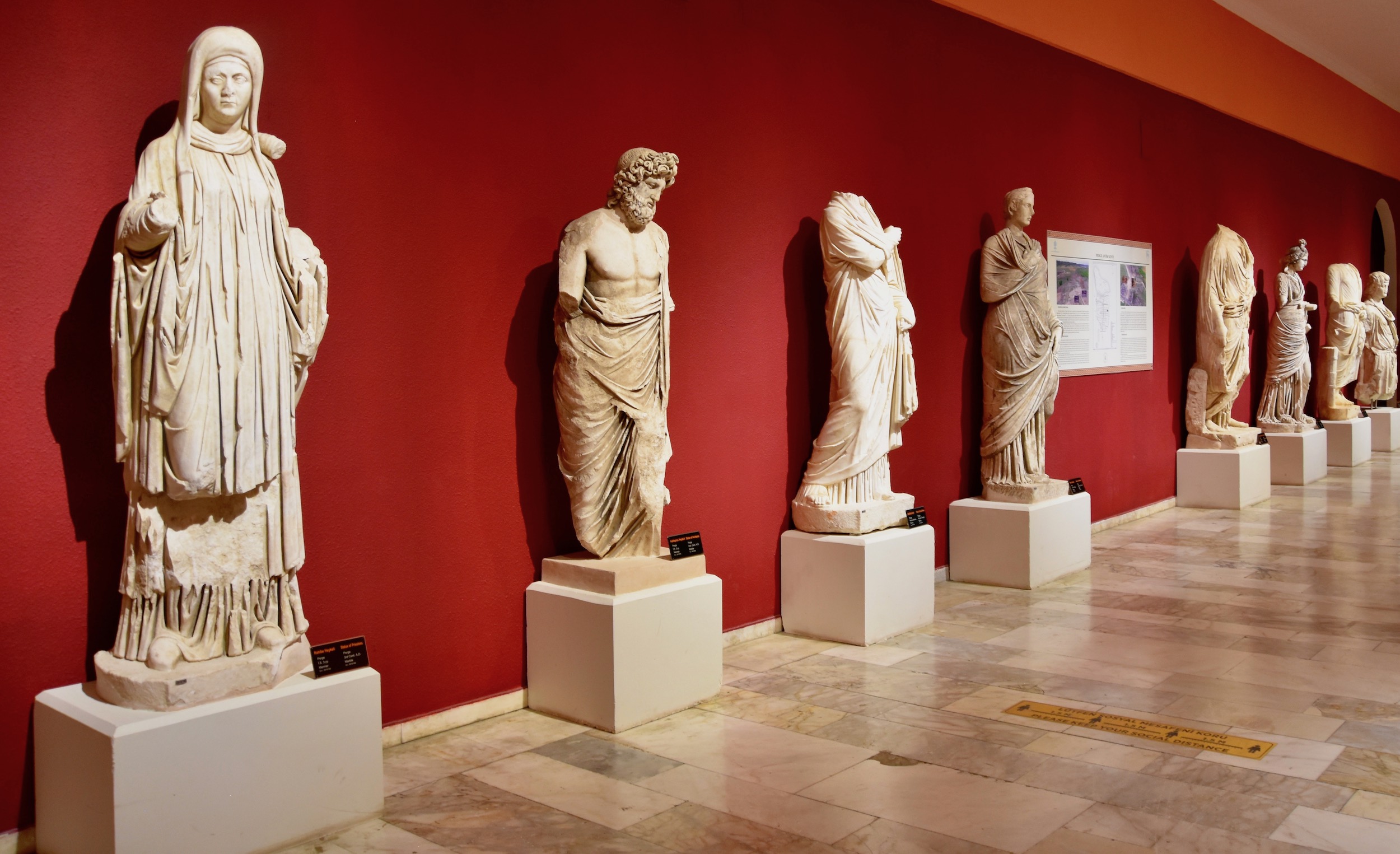
And now we look a little higher up, to Mount Olympus where we find statues of the Greek gods and their retinue which somewhat ironically are nowhere near as well done as the emperors. Here are a few of the most interesting starting with Isis. While this is not a great sculpture by any means, it is interesting because the importation of the Egyptian goddess into Roman beliefs is a great example of the ability of the empire to adapt to and adopt the deities of the lands that they conquered. This is in complete contrast to the later European practice in the Americas and elsewhere of trying to completely exterminate the native religions and replace it with Christianity. Mark Anthony is often credited with being the one who introduced Rome to Isis in the form of his lover, Cleopatra.
Look closely and you’ll see the foot of a child on her lap.
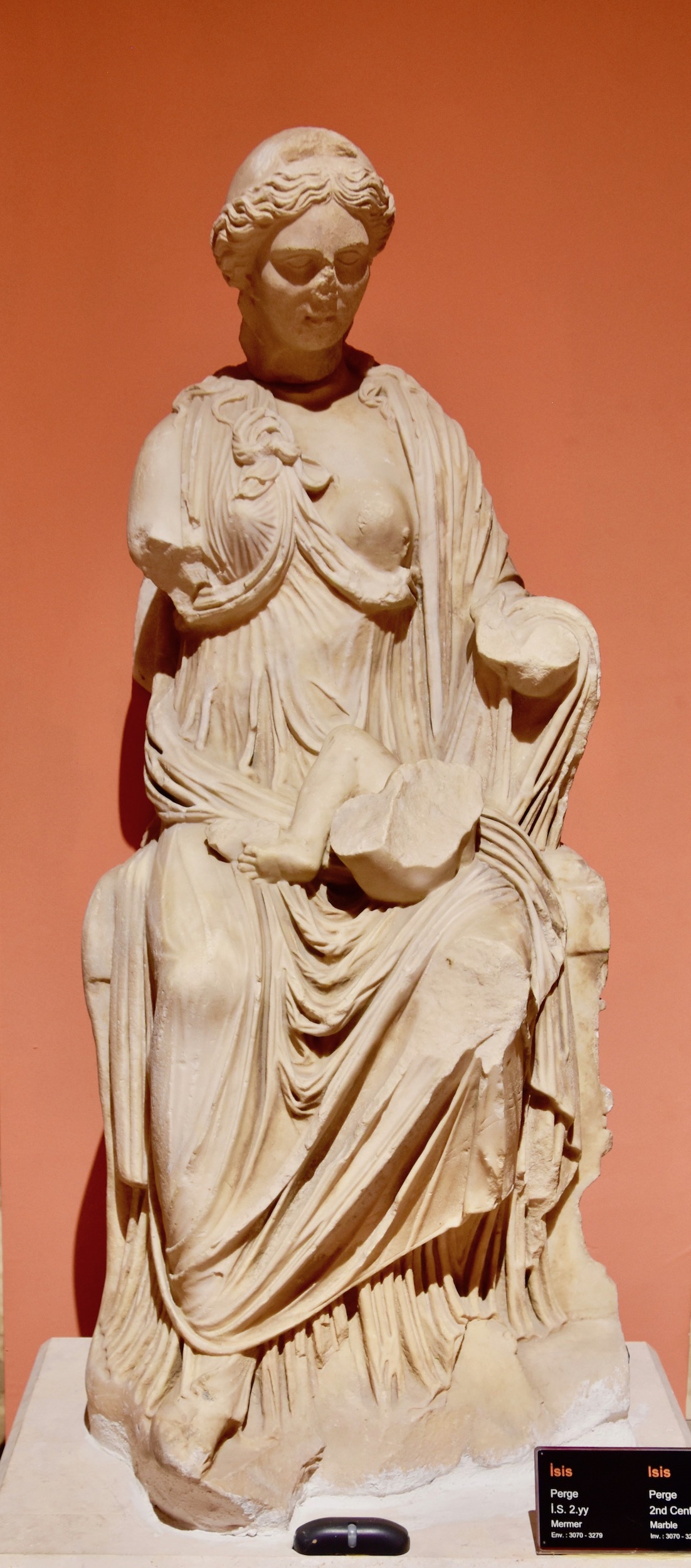
Next is the Greek god of healing Asclepius who we met at Galen’s Asclepeion in Pergamon. That’s a lot of hair and beard.
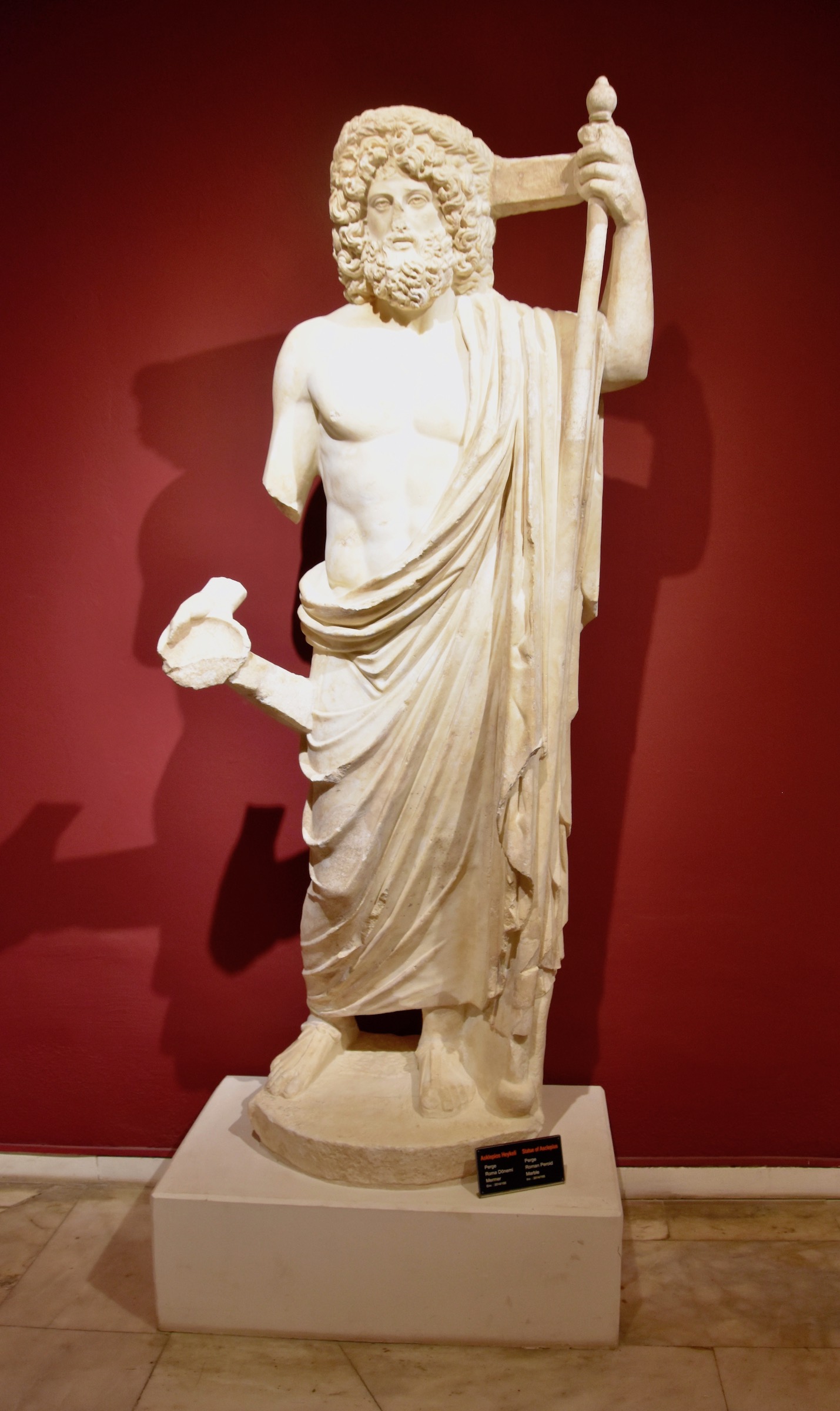
Next is a very popular lesser goddess Tykhe who was responsible for fortune and fate. Here image was often placed over theatres and other public buildings as a measure of good luck.
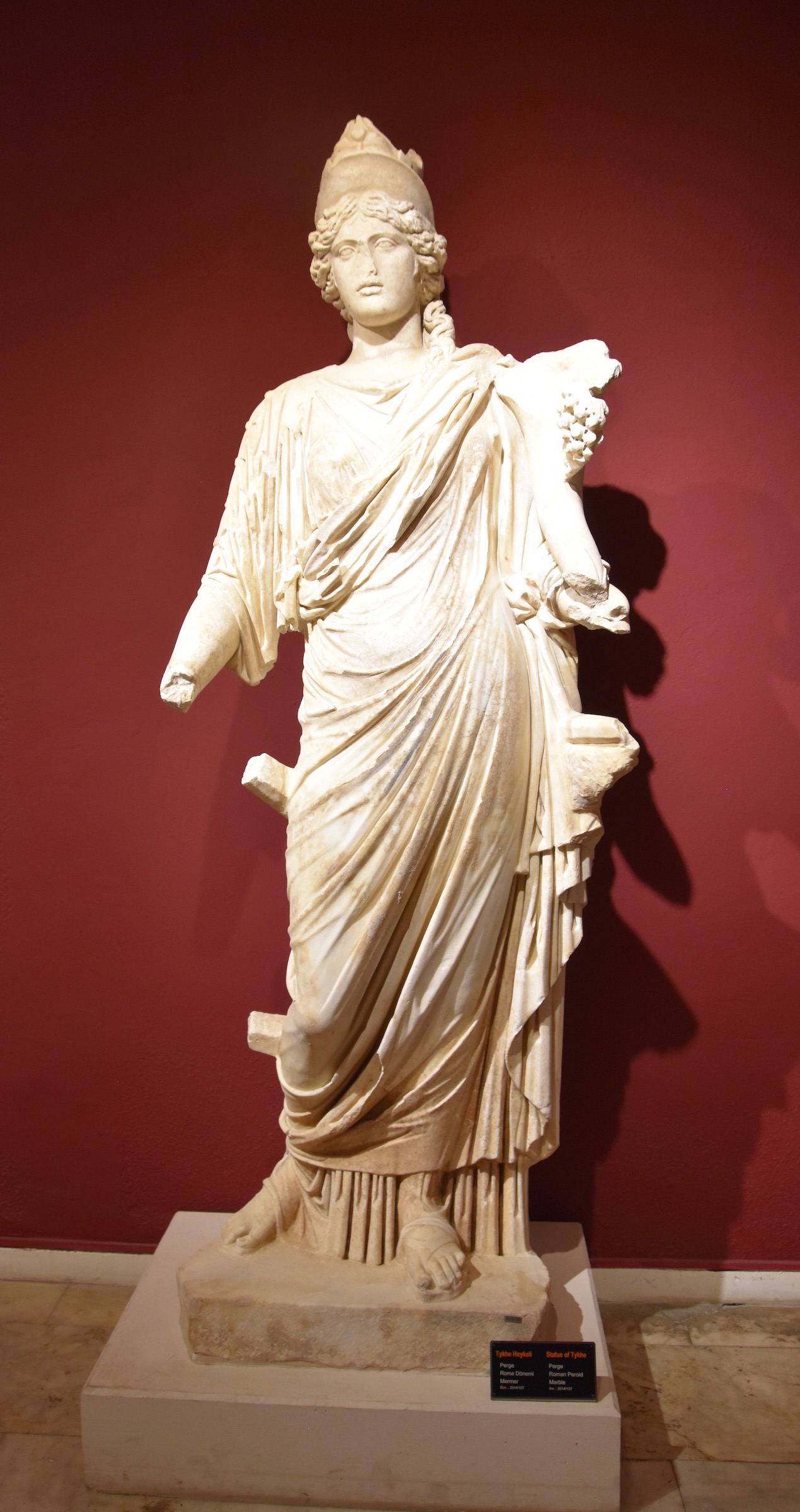
This is the three-headed version of the goddess Hecate, responsible for magic and witchcraft and a minor, but important player in Shakespeare’s Macbeth as she apparently is the overseer of the three witches in that play. She was also believed to be a guardian against evil spirits and thus the three heads looking in all directions from where she would be placed in a doorway. However, in this statue they are all looking at the camera.
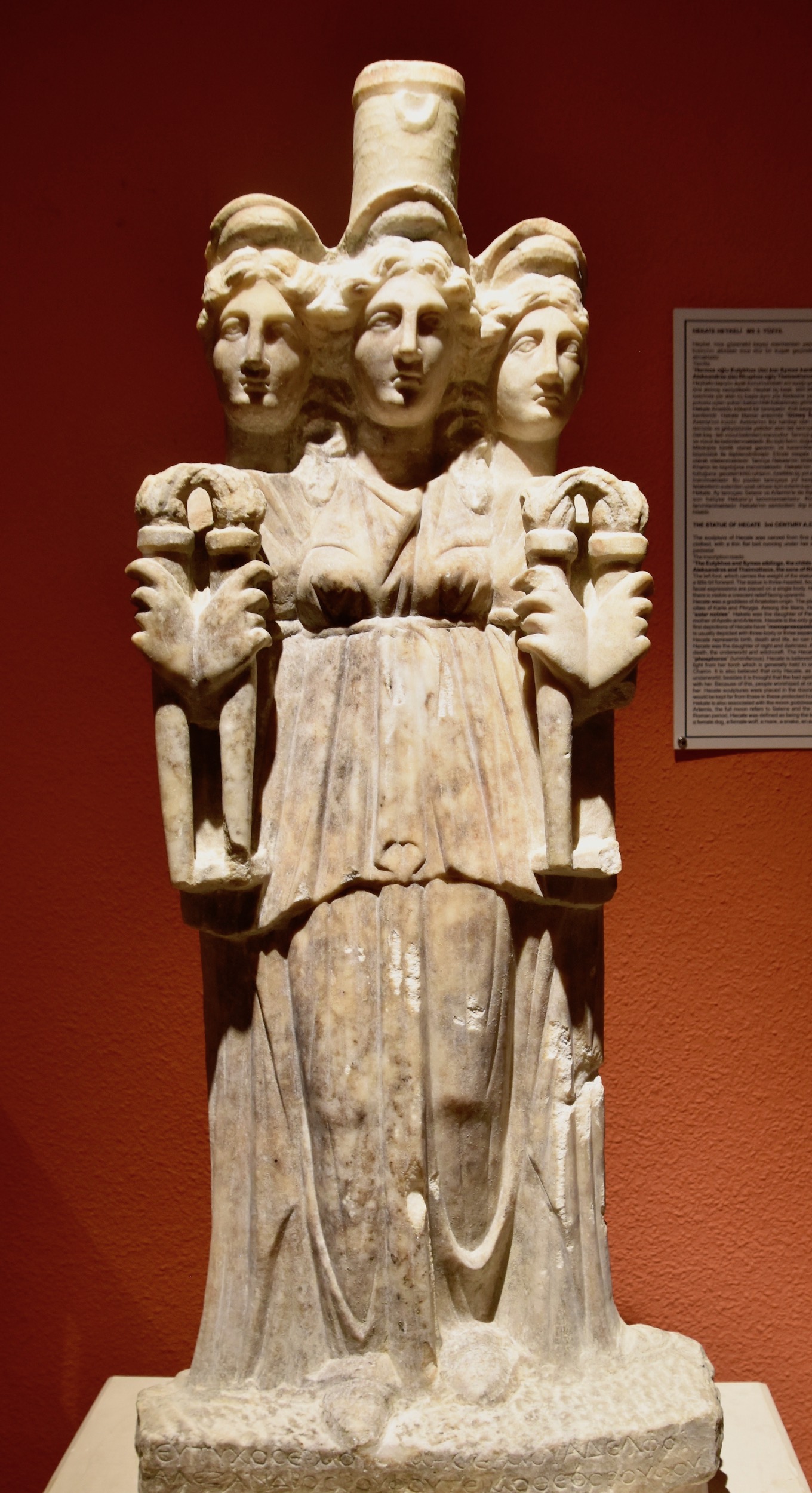
The final god is Hermes, messenger of the gods and conveyor of souls to their afterlife, usually with Hades in the underworld. What is quite unusual about this statue is that the wings that are either found on his feet or on the hat he wears (called a petasos) are growing right out of his head. 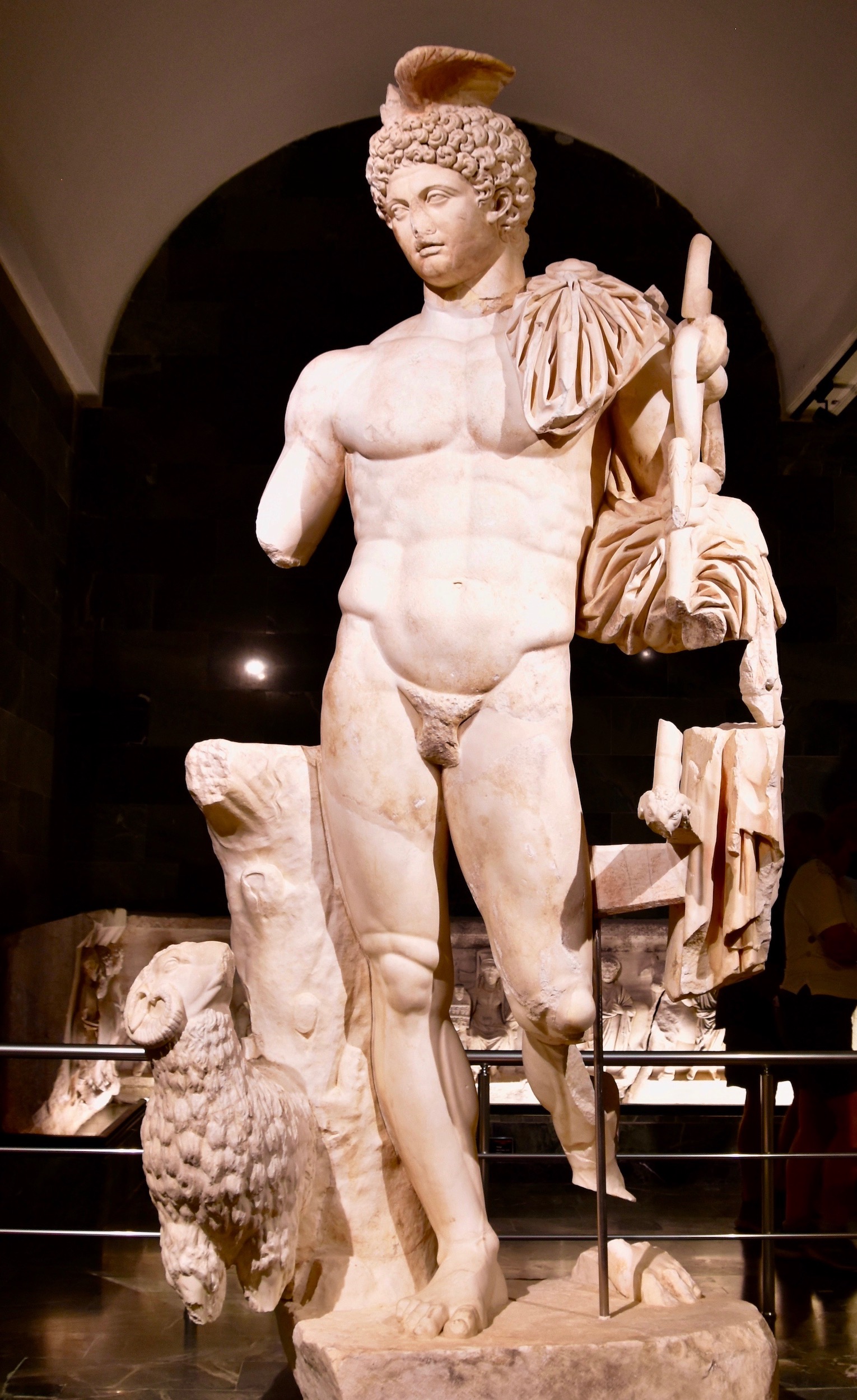 Hermes
Hermes
The next to last statue we’ll look at it is of Alexander the Great who was a huge presence in this part of the world, liberating the former Greek colonies from Persian rule and initiating the Hellenistic Period throughout the eastern Mediterranean. While not that much of the original is left you do get a sense of who this man was by staring into his baleful eyes that always seem to be a feature of his portraits.
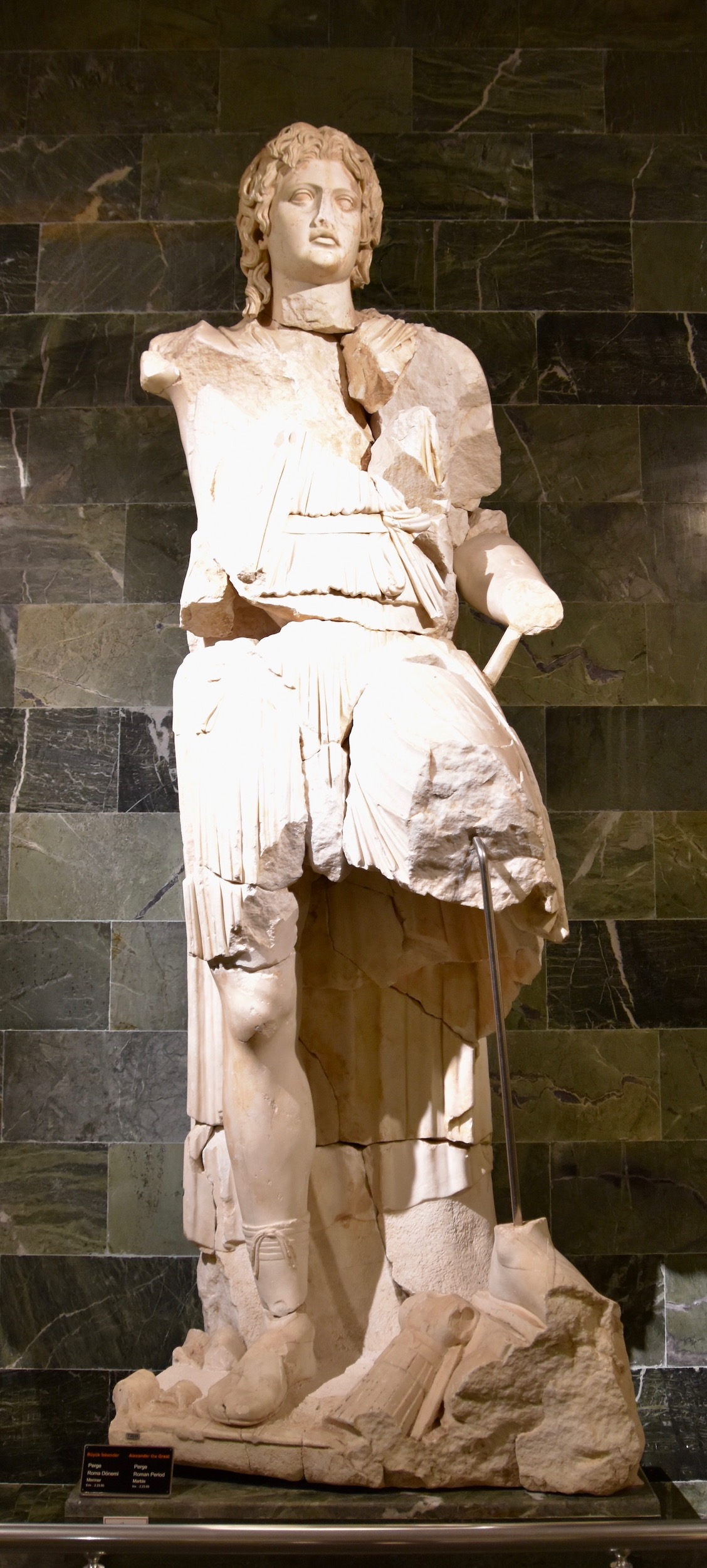
The Antalya Archaeological Museum is the repository of a number of pieces from the theatre of Perge including this very evocative one featuring the heads of six actors. This is placed over an entrance way much as it would have been in the original theatre and is quite compelling to look at.
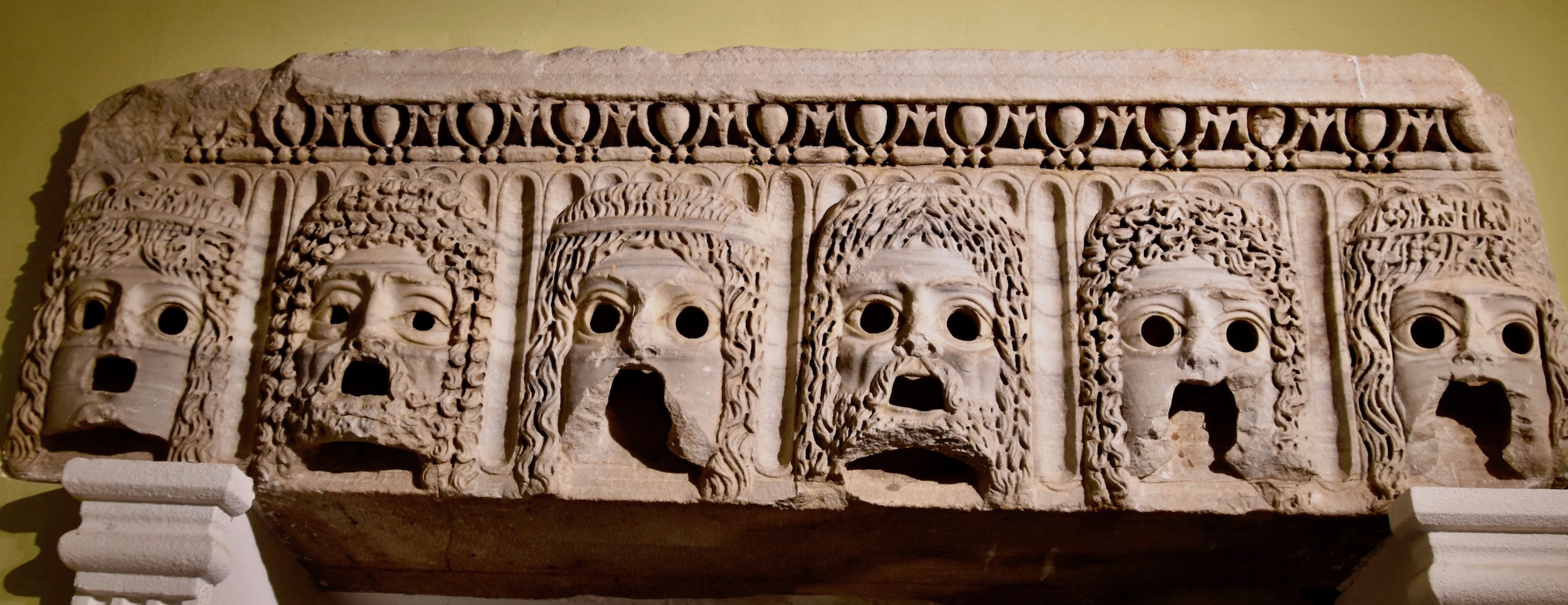
This is one of a number of friezes from the same theatre depicting what I believe to be a battle between the tritons on the left and nereids on the right who are armed with two vicious looking lions.

No trip to an archaeological museum in Turkey would be complete without a visit to the sarcophagi room and Antalya is no exception. It has a great collection of these stone tombs that all tell a different story and are great works of art in their own right.
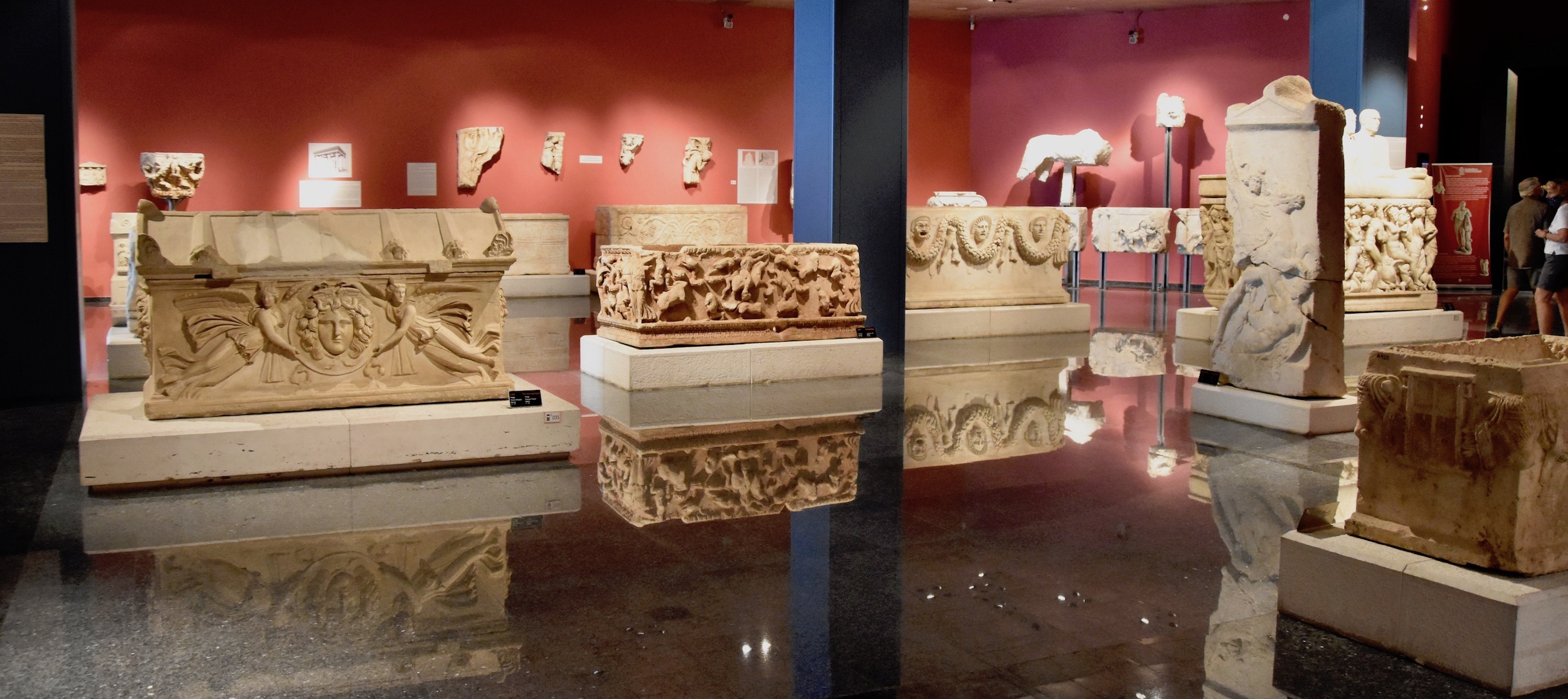
I’ll dwell on just two. This is called the Dionysius sarcophagus and you can see why with the riotous orgy taking place below these two distinctly creepy characters on top.
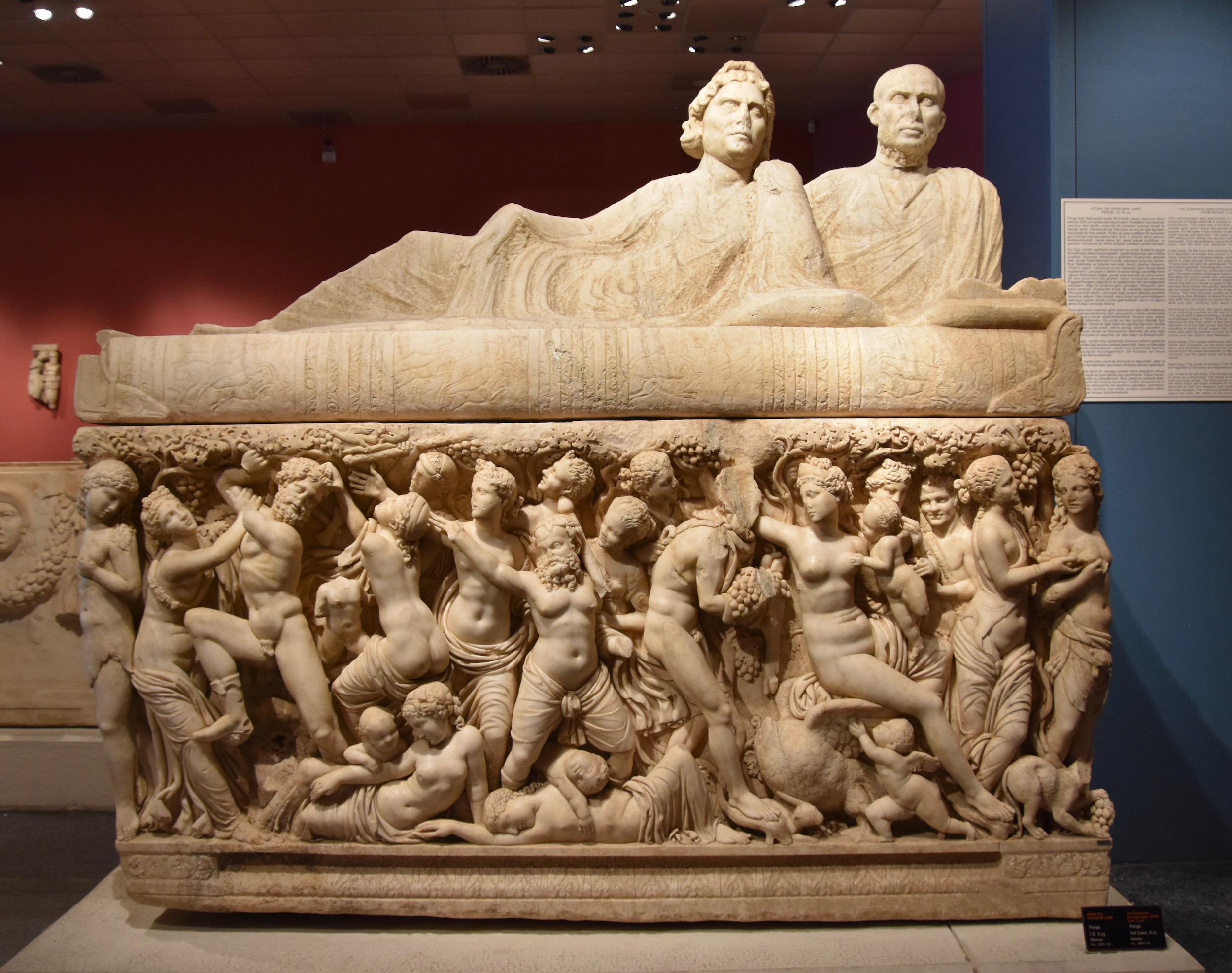
This is a detail from a sarcophagus that features the twelve labours of Herakles. In case you are wondering these five are as far as I can figure out from left to right – Killing the Cretan bull, capturing the mares of Diomedes, obtaining the belt of Hippolyta, rustling the cattle of Geryon and since these appear be in order from the 7th through the 10th the last one must be stealing the golden apples of the Hesperides, although that is not apparent.
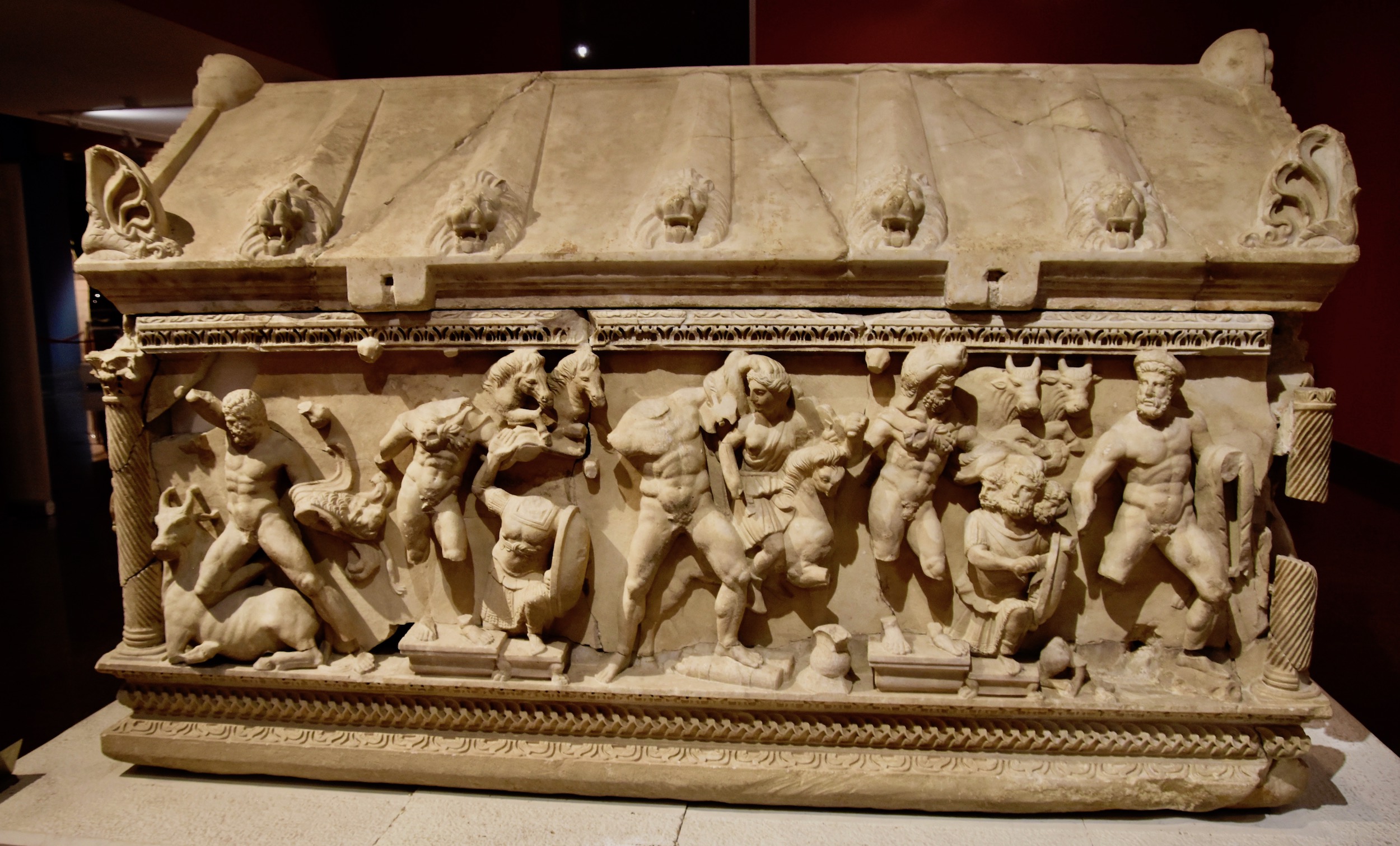
Speaking of Herakles, we’ll end our visit to the Antalya Archaeological Museum with what in my opinion is the best piece on display.
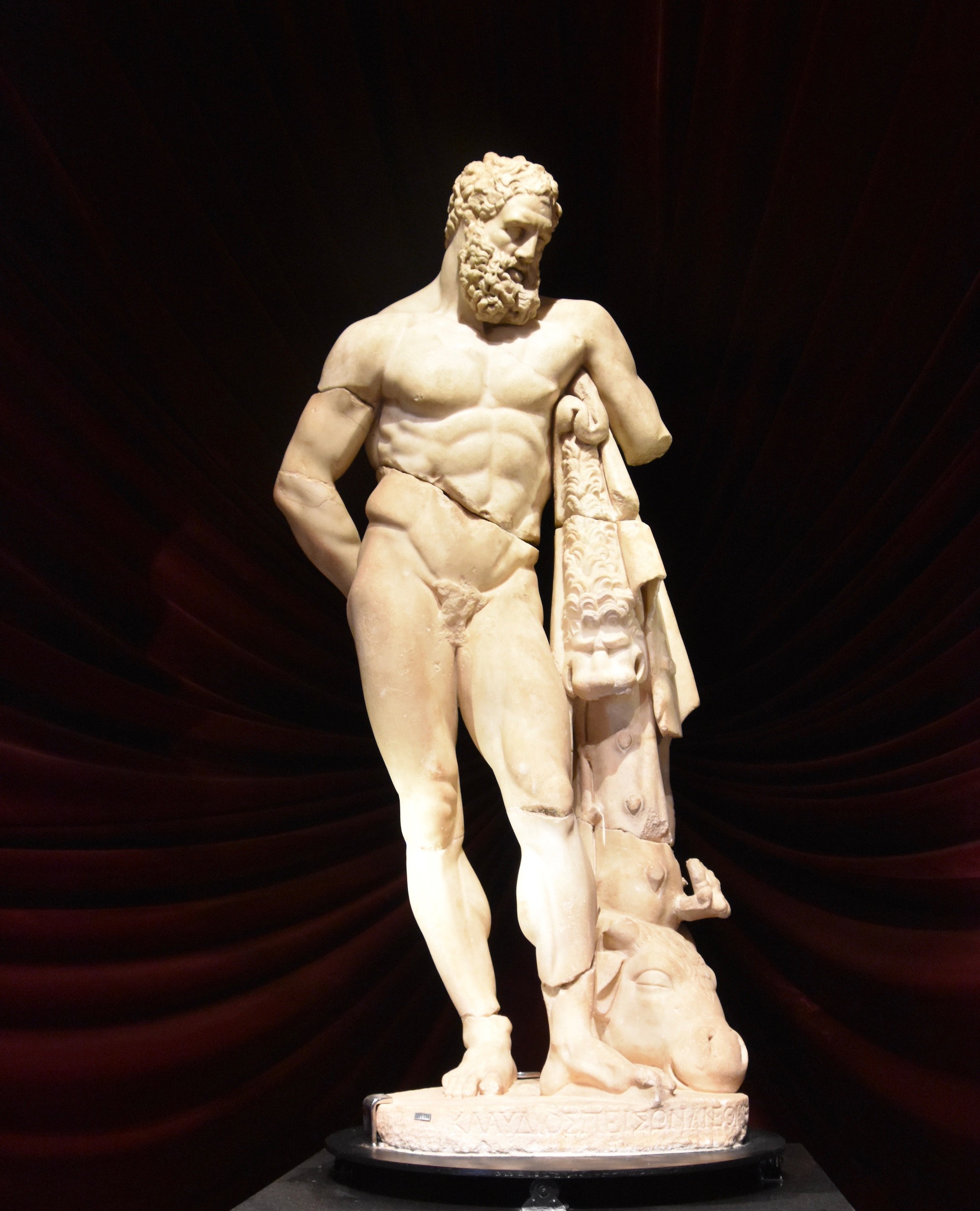
This is Weary Herakles, depicted after just completing on of his twelve labours – that appears to be the head of the Cretan bull at his feet. It is a Roman era copy of one of the most famous statues of Greek antiquity, the long lost bronze Herakles by Lysippos, one of the three great recognized sculptors from classical Greece. There are literally dozens of copies of this statue, but this one in Antalya is considered to be the finest and seeing it in person with this wonderful lighting, I certainly agree. It is simply amazing as is the story of how it came to be here.
You’ll notice that it is broken in half at the waist. The lower part was uncovered in Perge in the 1980’s, but the upper part was nowhere to be found. Then a Turkish journalist visiting the great Museum of Fine Arts in Boston saw what he thought must be the upper portion on display there. It had apparently been illegally smuggled out of Turkey some years earlier. When the museum learned of this they acceded to a request from the Turkish government to return it. Ever since 2014 Herakles has become whole again and is now a star attraction in Antalya.
On that happy note I’ll end this post and I hope I haven’t bored you with too many statues, but trust me, if you see them in person you will not be bored in the least.
In the next post we’ll visit the splendid theatre and aqueduct of Aspendos. Don’t miss it.

